Fujairah is a historic city in UAE known for its rich marine environment and archaeological finds dating back to the Iron Age. The Al Badiyah Mosque, the oldest known mosque in the UAE, and the 360-year-old Al Bithnah Fort are notable attractions. Visitors can also explore the Fujairah Heritage Village, Snoopy Island with its excellent snorkeling opportunities, and stop at Friday Makret for local fruits, handicrafts, and souvenirs along their route to Dubai.
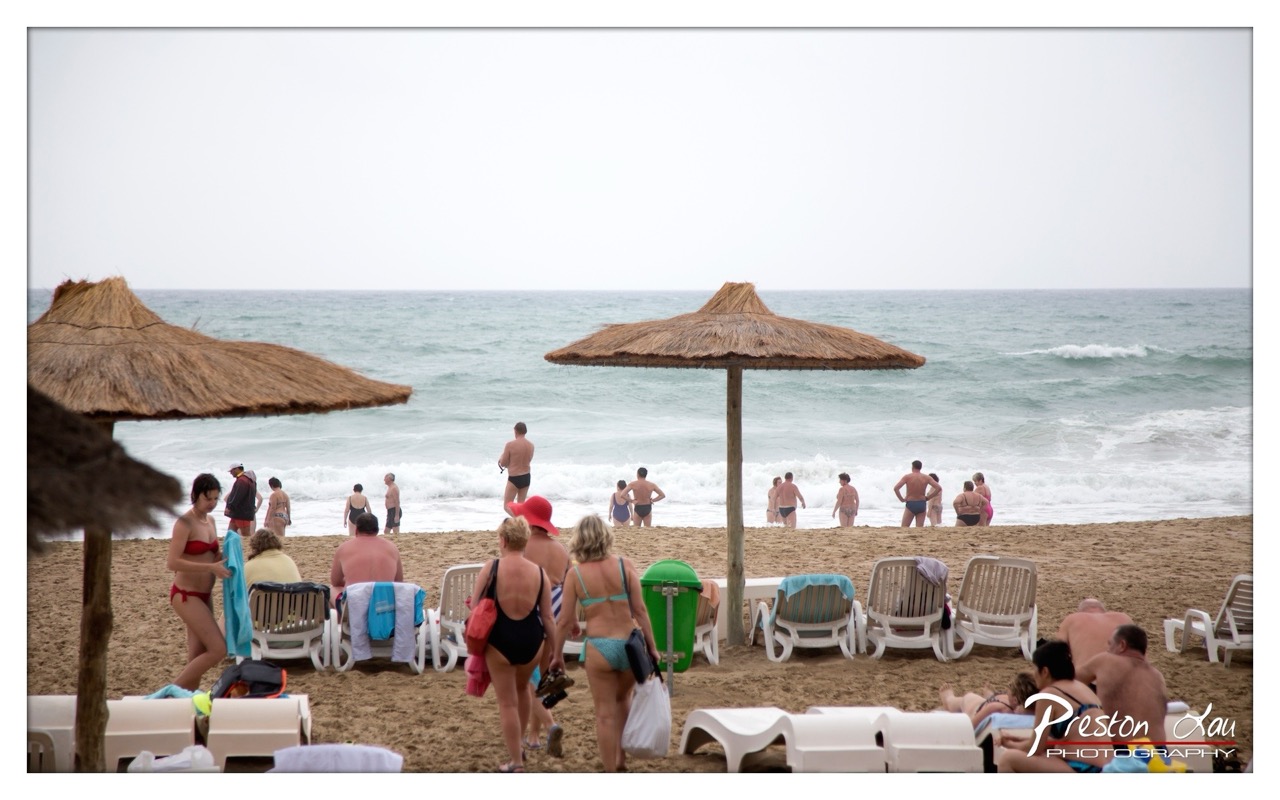

1. Overall Rating (0–10) — 6.0
This photograph captures a typical beach day with a sense of candid realism, where the rhythm of sunbathers and swimmers unfolds under an overcast sky. The muted tones and soft light lend a subdued, almost melancholic atmosphere, which contrasts with the expected vibrancy of a beach scene. While the image effectively documents a moment in time, it lacks the dynamic energy or visual drama to feel truly compelling, settling instead into a passive observation of everyday leisure.
2. Composition (0–10) — 6.0
The scene is framed with a wide perspective, placing the viewer at the edge of the beach experience. The thatched umbrellas anchor the foreground, while the ocean stretches across the middle ground, creating a layered depth. However, the lack of a clear focal point and the scattered arrangement of people and chairs result in a slightly chaotic composition that diffuses visual attention.
3. Lighting (0–10) — 5.5
The overcast sky produces even, diffused lighting that minimizes harsh shadows and allows for detail across the scene. While this ensures clarity in the mid-tones, it also flattens the image, robbing it of contrast and atmospheric depth. The light feels functional rather than expressive, contributing to the subdued mood.
4. Color & Tone (0–10) — 5.5
The palette is dominated by muted earth tones—beige sand, brown umbrellas, and pale blues in the water—punctuated only by occasional splashes of color from swimwear. The overall tonal range is narrow, and the lack of saturation dampens the visual excitement. The color temperature leans cool, reinforcing the overcast, subdued atmosphere.
5. Creativity (0–10) — 6.0
The photograph captures a familiar scene with an observational eye, but it stops short of conveying a unique perspective. The framing and subject matter are conventional, and while the mood is consistent, the image doesn’t push boundaries or invite deeper interpretation beyond its documentary function.
6. Technical Quality (0–10) — 7.5
The image is sharp and well-focused, with clean detail throughout. The depth of field is adequate, keeping both the foreground and background relatively clear. The watermark and exposure are handled cleanly, and there are no noticeable technical flaws.
7. Emotional Impact (0–10) — 5.0
The image evokes a sense of quiet detachment—more of a snapshot than an emotional experience. The overcast conditions and lack of vivid interaction or dramatic moments keep the viewer at a distance, making it difficult to fully connect with the people or the setting.
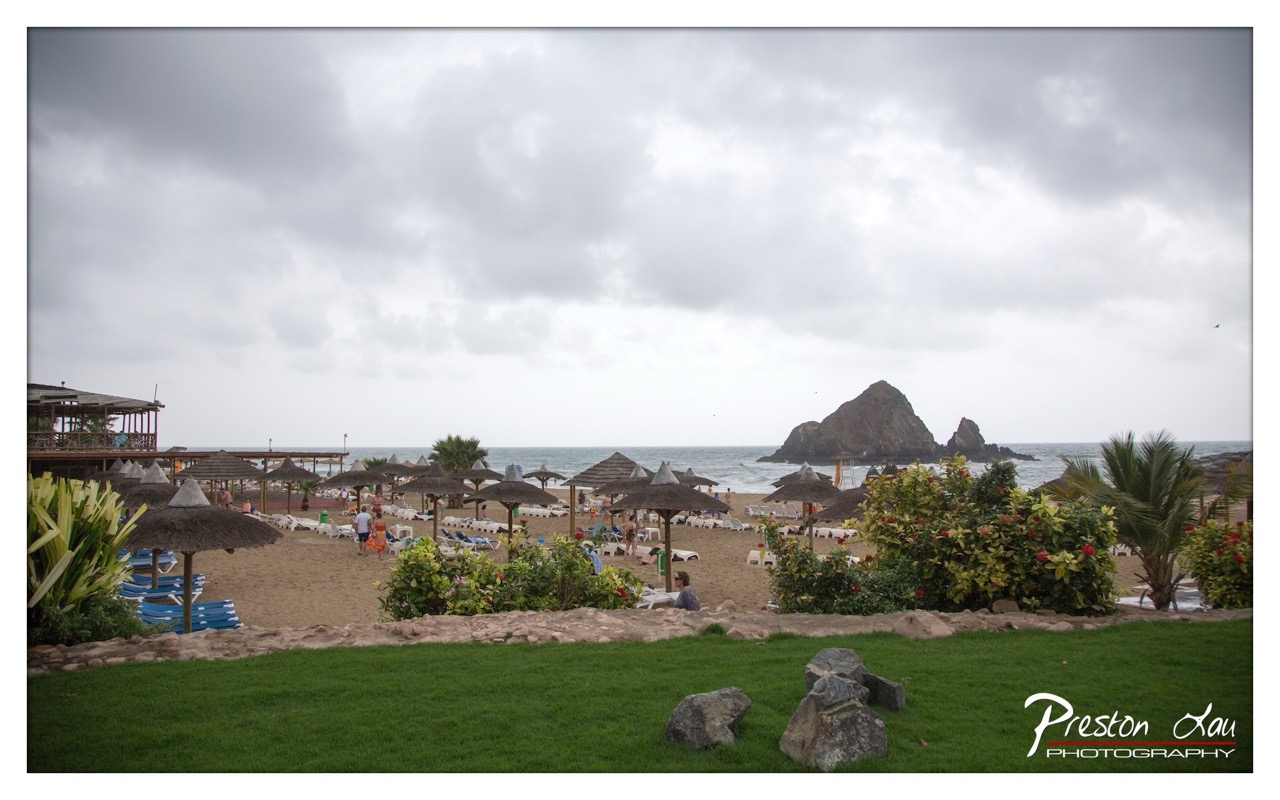

1. Overall Rating (0–10) — 6.0
This photograph captures a tranquil yet overcast beach scene, where the muted sky and subdued tones evoke a quiet, contemplative mood. While the composition frames a picturesque coastal landscape with natural and man-made elements in harmony, the lack of vibrant light and dynamic energy keeps the image from fully engaging the viewer. The scene feels authentic and atmospheric, but it lacks the visual punch to elevate it beyond a simple snapshot.
2. Composition (0–10) — 6.5
The image is well-framed with a clear foreground of grass and rocks, leading the eye toward the beach and distant sea. The arrangement of umbrellas and palm trees creates a sense of depth, though the slightly off-center horizon and scattered elements give a slightly unbalanced feel.
3. Lighting (0–10) — 5.0
The overcast sky results in flat, diffused lighting that softens textures and reduces contrast. While this creates a uniform exposure, it also dampens the scene’s visual richness and emotional intensity.
4. Color & Tone (0–10) — 5.5
The palette is dominated by muted greens, grays, and sandy beige, with only subtle pops of color from the flowers and lounge chairs. The lack of saturation gives the image a subdued, almost melancholic tone.
5. Creativity (0–10) — 6.0
The photographer captures a moment of calm in a busy beach setting, emphasizing atmosphere over action. The inclusion of natural and man-made elements tells a quiet story of leisure and stillness, though the concept is executed in a conventional way.
6. Technical Quality (0–10) — 7.5
The image is sharp and well-exposed, with good detail in both the foreground and background. The focus is consistent, and the watermark is cleanly placed, indicating a solid technical foundation.
7. Emotional Impact (0–10) — 5.5
The mood is reflective and peaceful, but the lack of dramatic light and emotional contrast prevents a deeper connection. The viewer is invited to observe rather than feel, resulting in a mild emotional resonance.
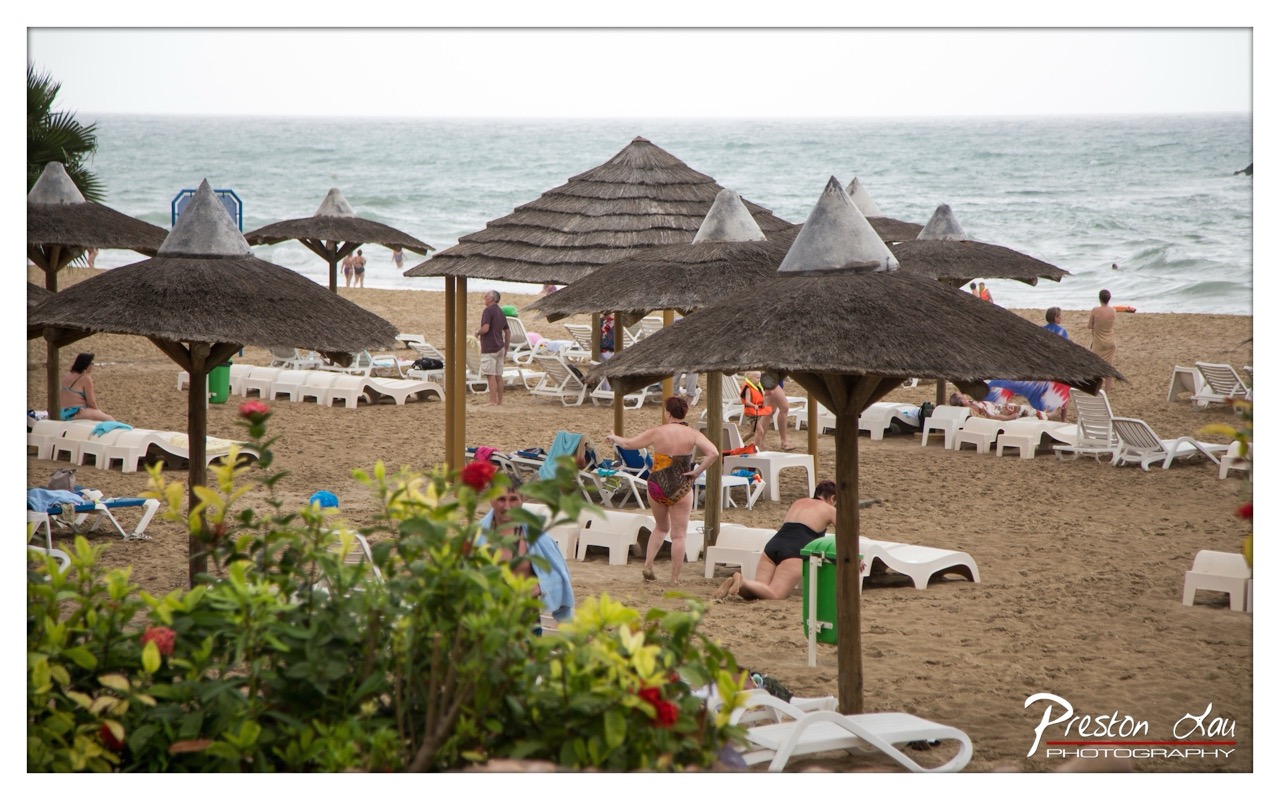

1. Overall Rating (0–10) — 6.0
This photograph captures a tranquil yet slightly overcast day at a crowded beach, where the rhythm of leisure unfolds beneath thatched umbrellas and white loungers. The muted sky and calm waves lend a subdued mood, while the foreground foliage adds a touch of natural framing. Though the scene feels authentic and lived-in, the lack of dynamic light and emotional intensity keeps it from resonating deeply, feeling more like a snapshot than a moment frozen in time.
2. Composition (0–10) — 6.5
The image is well-framed with a layered approach—foreground foliage, midground beach activity, and distant sea—creating depth. However, the scattered placement of umbrellas and people introduces visual clutter, and the central figure’s movement draws the eye without a clear focal point.
3. Lighting (0–10) — 5.5
Diffuse, overcast lighting flattens the scene, reducing contrast and depth. While it prevents harsh shadows, it also diminishes the vibrancy and mood typically associated with a beach setting.
4. Color & Tone (0–10) — 6.0
The palette is dominated by neutral beige sand, pale blue-gray water, and muted greens, creating a cohesive but subdued atmosphere. The red flowers in the foreground offer a small burst of color, but the overall tonal range remains soft and underexposed.
5. Creativity (0–10) — 5.5
The image presents a familiar beach scene with a slightly observational, documentary-style approach. While the composition attempts narrative through layering, it lacks a strong conceptual or emotional hook to elevate it beyond a standard travel photograph.
6. Technical Quality (0–10) — 7.5
Sharp focus and clean detail are present throughout, especially in the foreground. The image is well-exposed and free of noticeable noise or technical flaws, though the overall tone appears slightly dull.
7. Emotional Impact (0–10) — 5.0
The mood is calm and reflective, yet emotionally distant. The overcast sky and quiet activity evoke a sense of peacefulness, but the lack of human connection or dramatic light prevents a deeper emotional pull.
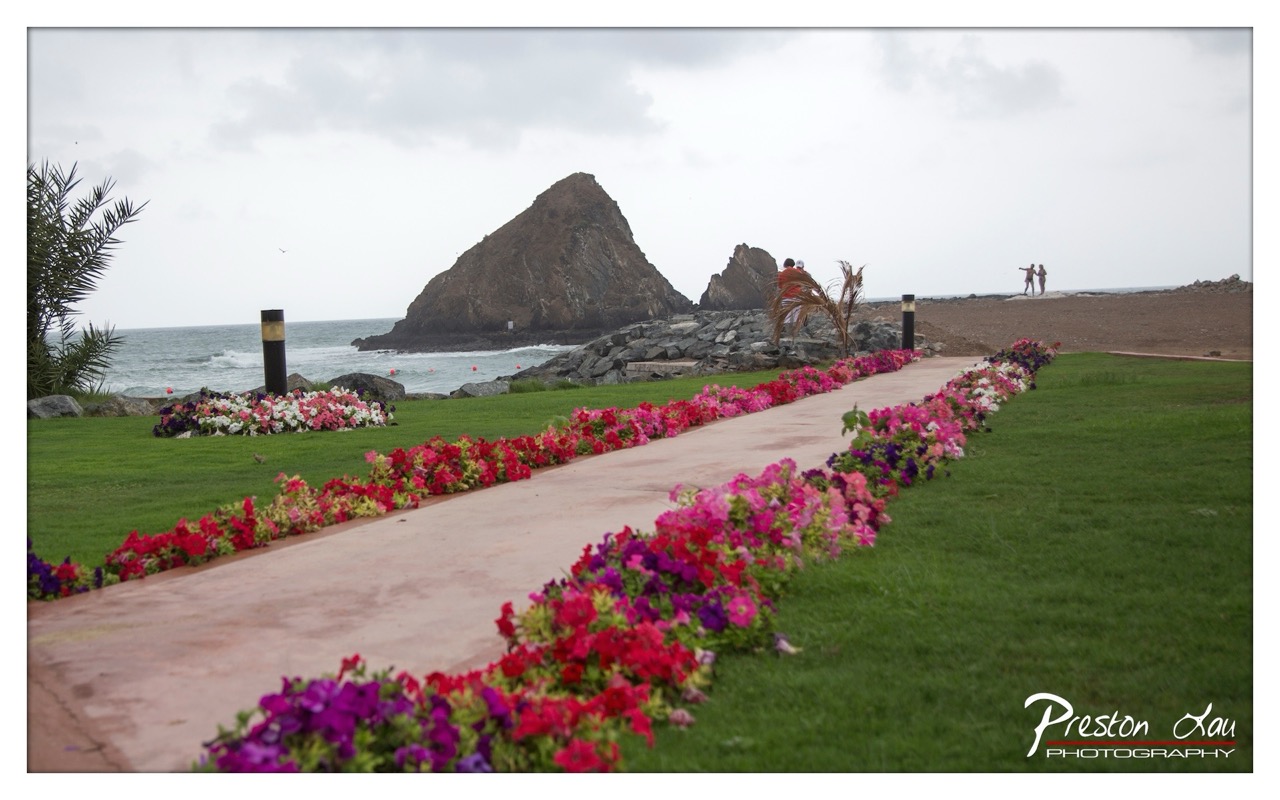

1. Overall Rating (0–10) — 7.0
This photograph captures a tranquil coastal scene where vibrant flowers line a path leading toward a dramatic sea-facing rock formation, creating a compelling visual journey. The contrast between the manicured garden and the wild, overcast coastline lends a quiet poetic tension. While the lighting is subdued and the colors slightly muted, the composition draws the eye naturally toward the horizon, evoking a sense of calm exploration and subtle adventure.
2. Composition (0–10) — 7.5
The diagonal pathway creates a strong leading line, guiding the viewer’s gaze from the foreground through the frame toward the distant rock and sea. The placement of the figures on the right adds a sense of scale and human presence without disrupting the scene’s serenity.
3. Lighting (0–10) — 5.5
The overcast sky produces soft, diffused light that minimizes harsh shadows but also flattens the scene’s depth. While it enhances the moody atmosphere, the lack of directional light reduces texture and contrast in the rocks and foliage.
4. Color & Tone (0–10) — 6.5
The vivid purples, pinks, and reds of the flowers stand out against the green grass and muted gray-blue sea, creating a pleasing contrast. However, the overall tone is slightly cool and desaturated, which dampens the vibrancy of the blooms.
5. Creativity (0–10) — 7.0
The juxtaposition of cultivated beauty and natural ruggedness offers a unique visual narrative. The framing emphasizes perspective and movement, transforming a simple landscape into a contemplative journey.
6. Technical Quality (0–10) — 7.0
The image is sharp and well-focused throughout, with clean detail in the flowers and grass. The exposure is balanced, though a slight underexposure in the sky and water reduces dynamic range.
7. Emotional Impact (0–10) — 6.5
The scene evokes a sense of peaceful solitude and quiet wonder, inviting the viewer to imagine walking the path and contemplating the vastness of the sea. The muted palette tempers the emotional intensity, but the composition fosters a reflective, meditative mood.
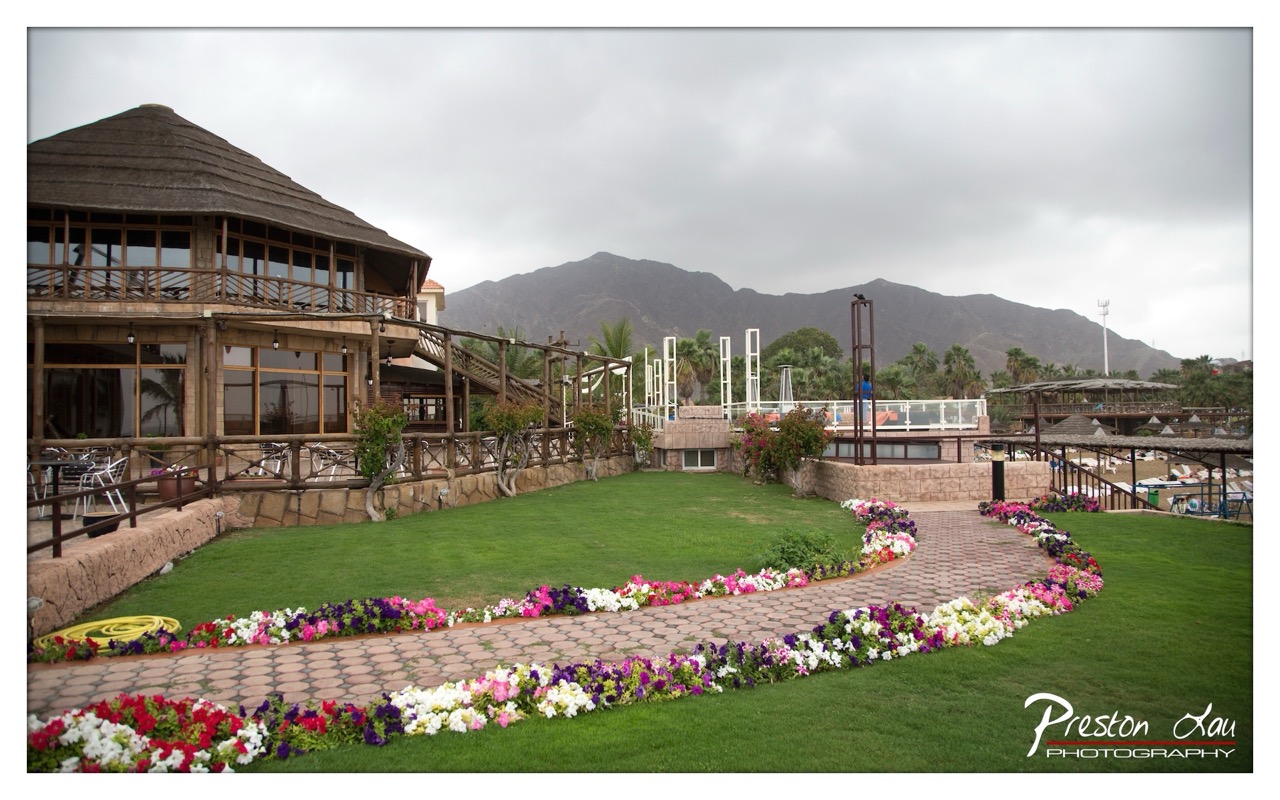

1. Overall Rating (0–10) — 6.8
This photograph presents a tranquil resort landscape, where vibrant flower beds and a rustic pavilion harmonize with the rugged mountains in the distance. The composition draws the eye along the curving path, offering a sense of calm and leisure, though the overcast sky tempers the scene’s natural warmth. While the image captures a picturesque moment, it lacks the dynamic energy to feel truly compelling—its beauty is restrained by a muted atmosphere and a somewhat conventional framing.
2. Composition (0–10) — 7.0
The winding path creates a strong leading line, guiding the viewer from the foreground into the middle ground, where the pavilion and mountains form a balanced backdrop. The diagonal placement of the building adds visual interest, though the right side feels slightly underdeveloped, leaving a sense of asymmetry.
3. Lighting (0–10) — 5.5
Diffused light from the overcast sky creates soft, even illumination, minimizing harsh shadows and preserving detail across the scene. However, the lack of sunlight diminishes depth and vibrancy, lending a subdued tone that contrasts with the colorful flowers.
4. Color & Tone (0–10) — 6.5
The palette is rich with the pinks, purples, and whites of the blossoms, which stand out against the green lawn and earthy tones of the structure. The muted sky and stone elements keep the overall tone subdued, creating a gentle contrast that works well but lacks the punch of a more dramatic lighting condition.
5. Creativity (0–10) — 6.0
The image captures a familiar resort aesthetic with a focus on natural beauty and harmony. While the composition is thoughtful and the subject is visually appealing, the concept remains conventional—there is little sense of narrative or unique perspective that sets it apart from standard travel photography.
6. Technical Quality (0–10) — 7.5
Sharp focus is maintained across the frame, from the foreground flowers to the distant mountains. The exposure is well-balanced, and the image shows no obvious flaws in clarity or noise, suggesting strong technical execution.
7. Emotional Impact (0–10) — 6.0
The photograph evokes a sense of peaceful retreat and relaxation, inviting the viewer to imagine a quiet escape. However, the lack of dynamic light and emotional intensity keeps the connection to the scene somewhat detached, limiting its ability to stir deeper resonance.
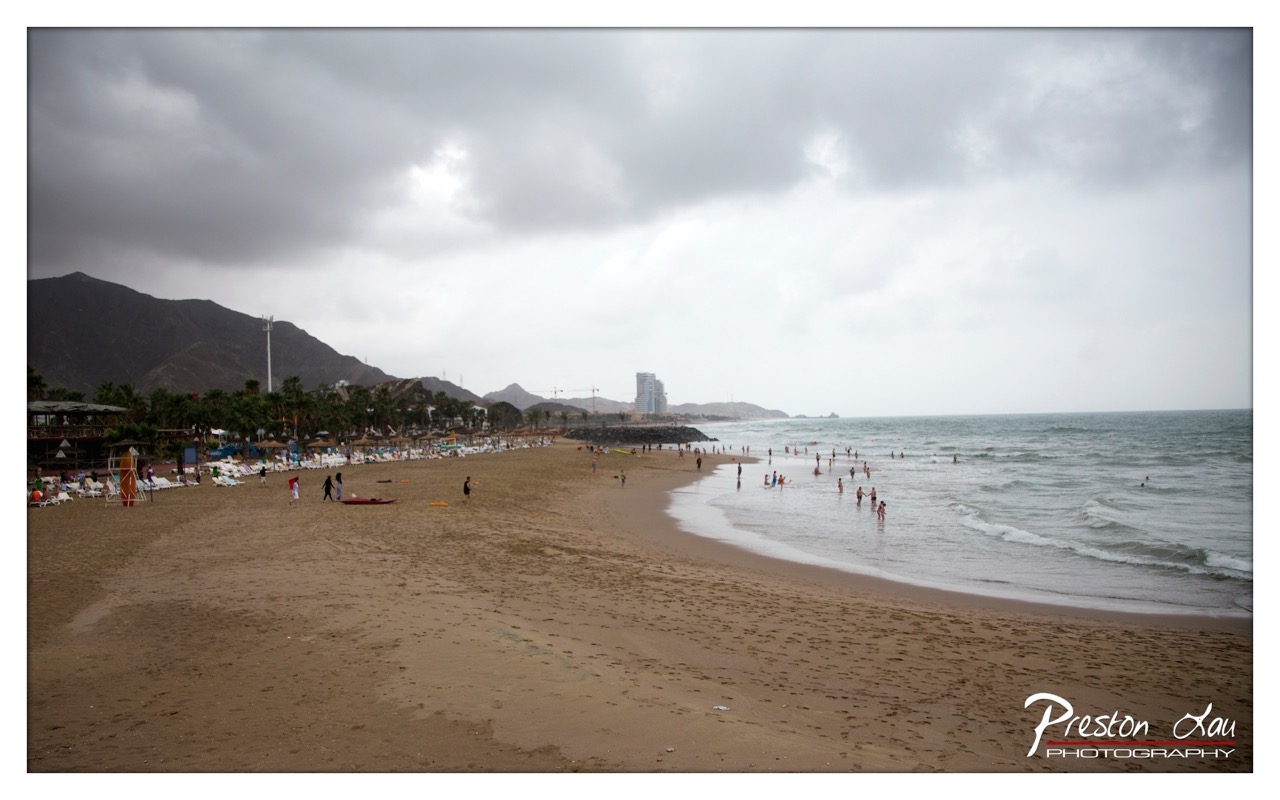

1. Overall Rating (0–10) — 6.0
This photograph captures a moody, overcast day at a bustling beach, where the tension between human activity and nature’s somber mood creates a quiet drama. The heavy sky and muted tones lend a contemplative atmosphere, yet the image feels slightly restrained by its lack of visual focus and emotional depth. While the scene is well-documented, it struggles to elevate the moment into something truly compelling.
2. Composition (0–10) — 5.5
The wide-angle perspective offers a sweeping view of the beach, but the subject placement is uneven, with too much empty sand in the foreground and a distant, cluttered background. The diagonal line of the shoreline provides some movement, but the composition lacks a clear focal point.
3. Lighting (0–10) — 5.0
The flat, diffused light from the overcast sky results in low contrast and a washed-out appearance. While it captures the gloomy weather effectively, it diminishes the texture and vibrancy of the scene, leaving the image feeling visually subdued.
4. Color & Tone (0–10) — 5.5
The palette is dominated by muted grays and sandy browns, with only subtle hints of color from beach umbrellas and swimwear. The lack of saturation and dynamic range gives the image a dull, almost monochromatic feel, which undermines its potential impact.
5. Creativity (0–10) — 6.0
The photographer captures a realistic moment of everyday life at a beach, but the approach is more documentary than artistic. The mood is atmospheric, but the image doesn’t push beyond the literal to offer a deeper interpretation or narrative.
6. Technical Quality (0–10) — 7.0
The image is sharp and well-exposed, with clean detail across the frame. The focus is consistent, and the wide dynamic range handles the bright water and dark clouds adequately, though post-processing could have enhanced the tonal balance.
7. Emotional Impact (0–10) — 5.0
The photograph evokes a sense of quiet melancholy and isolation, but the emotional resonance is muted by the lack of a strong focal point or narrative thread. It feels like a snapshot rather than a moment of reflection, leaving the viewer with a vague impression rather than a lasting impression.
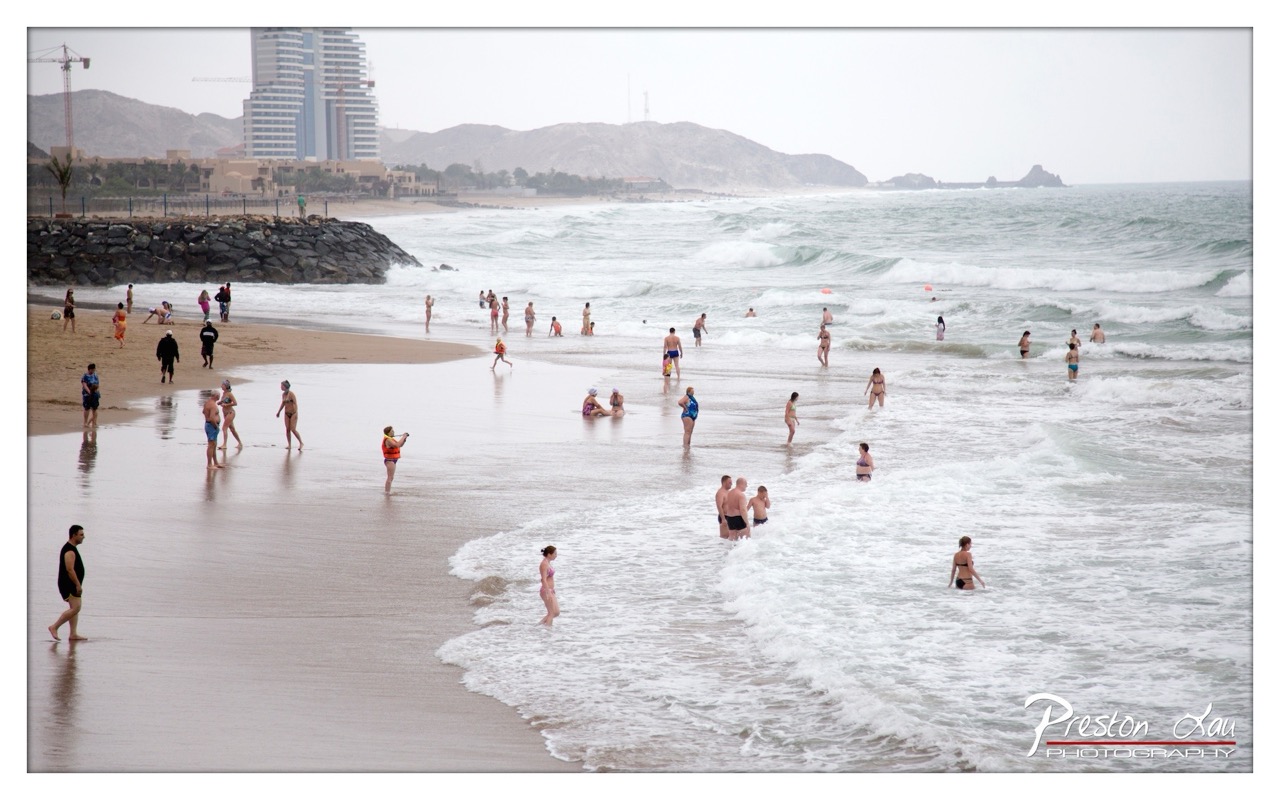

1. Overall Rating (0–10) — 6.0
This photograph captures a lively beach scene under an overcast sky, where the energy of human activity contrasts with the subdued mood of the weather. The composition effectively balances the bustling foreground with the distant urban and natural landscape, creating a sense of place. While the lighting and color palette lend a somber tone, the presence of swimmers and strollers gives the image a quiet vitality. The image feels more documentary than artistic, missing a decisive moment or emotional punch that would elevate it beyond a casual snapshot.
2. Composition (0–10) — 6.5
The wide frame includes a broad range of elements—beachgoers, waves, cityscape, and mountains—creating a layered narrative. The diagonal flow of the shoreline guides the eye from left to right, though the scattered figures lack a clear focal point, resulting in a somewhat diffuse center of interest.
3. Lighting (0–10) — 5.5
Diffuse, overcast lighting flattens contrast and softens details, giving the scene a muted, gray tone. While this suits the atmospheric mood, it diminishes the vibrancy of the water and sand, making the image feel less dynamic.
4. Color & Tone (0–10) — 5.0
The palette is dominated by muted blues, grays, and beige, reflecting the cloudy sky and wet sand. While cohesive, the lack of saturation weakens the visual impact and makes the scene appear less inviting than a sunlit beach should.
5. Creativity (0–10) — 6.0
The image captures a realistic moment with a sense of place, blending urban development with natural coastal life. However, it lacks a strong conceptual or emotional hook, relying instead on the authenticity of the scene rather than a bold artistic vision.
6. Technical Quality (0–10) — 7.5
The image is sharp and well-exposed, with good detail in the water and background structures. Focus is consistent across the frame, and the photographer has captured a clear moment without technical flaws.
7. Emotional Impact (0–10) — 5.5
The scene evokes a sense of everyday life—casual recreation amid a developed coastline—but the overcast conditions temper the usual joy of a beach day. The emotional resonance is modest, offering a quiet observation rather than a powerful connection.
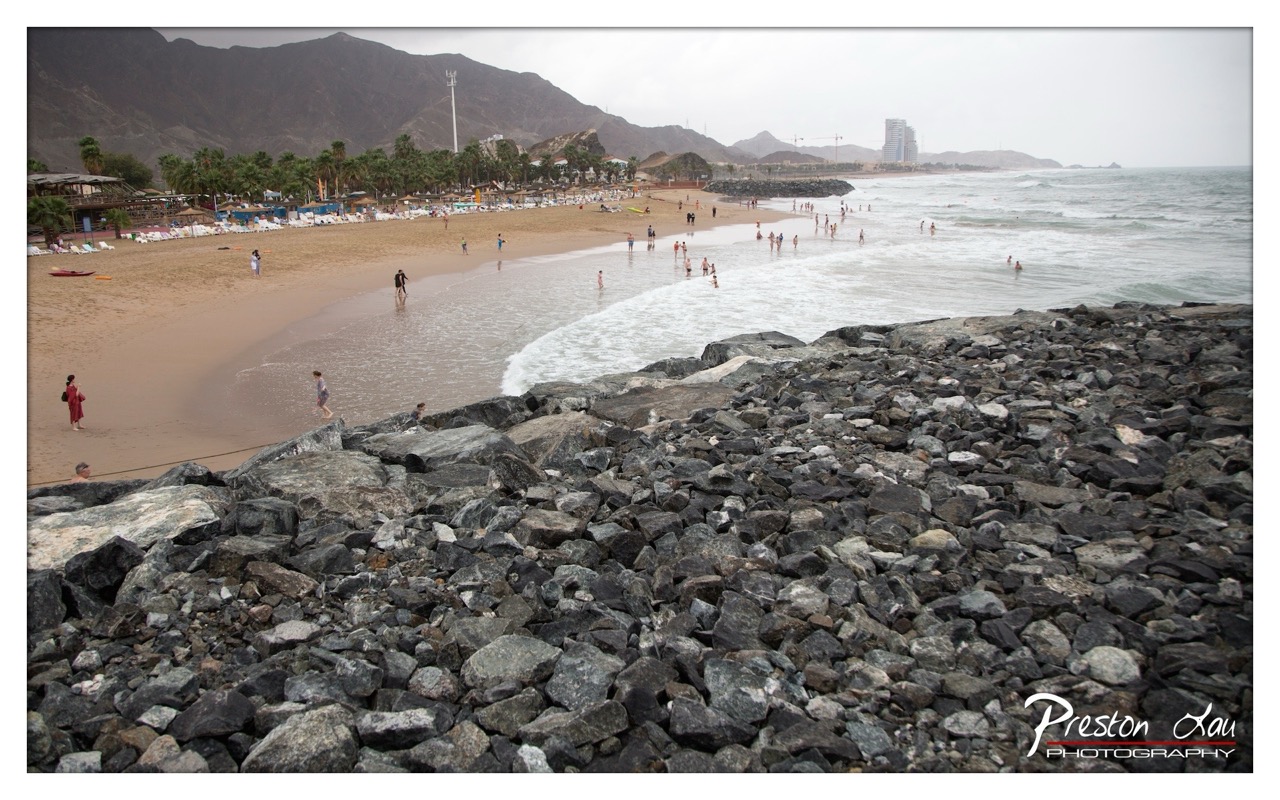

1. Overall Rating (0–10) — 6.0
This photograph captures a layered coastal scene where natural ruggedness meets human leisure, creating a quiet tension between wild and cultivated landscapes. The foreground’s jagged rocks anchor the image with weight and texture, while the distant beachgoers and palm-lined shore suggest a sense of life and recreation. However, the overcast sky and muted tones dull the energy of the scene, making it feel more observational than evocative—documentary in spirit but lacking emotional pull.
2. Composition (0–10) — 6.5
The foreground rocks create a strong diagonal leading into the frame, guiding the eye toward the beach and mountains. The scattered figures provide scale and narrative, though their small size and scattered placement slightly dilute focus.
3. Lighting (0–10) — 5.0
Diffuse, overcast lighting flattens the scene, reducing depth and shadow contrast. While it evenly illuminates the landscape, it also suppresses mood and highlights the lack of sunlight, giving the image a subdued, almost gray tone.
4. Color & Tone (0–10) — 5.5
The palette is dominated by muted earth tones—grays, browns, and pale greens—lending a natural but subdued quality. The lack of vibrant color or tonal contrast keeps the image from feeling dynamic or visually striking.
5. Creativity (0–10) — 6.0
The juxtaposition of the rocky, almost industrial foreground with the leisurely beach and distant mountains offers a compelling narrative about environment and human presence. While not groundbreaking, the framing suggests a thoughtful engagement with place and scale.
6. Technical Quality (0–10) — 7.5
Sharp focus and clean detail are evident across the frame, particularly in the foreground rocks. The image is well-exposed, with no significant technical flaws, though the lack of dynamic lighting limits visual impact.
7. Emotional Impact (0–10) — 5.5
The image conveys a sense of calm and quiet observation, but the lack of warmth or dramatic light prevents a deeper emotional connection. It feels more like a travel snapshot than a powerful visual statement.
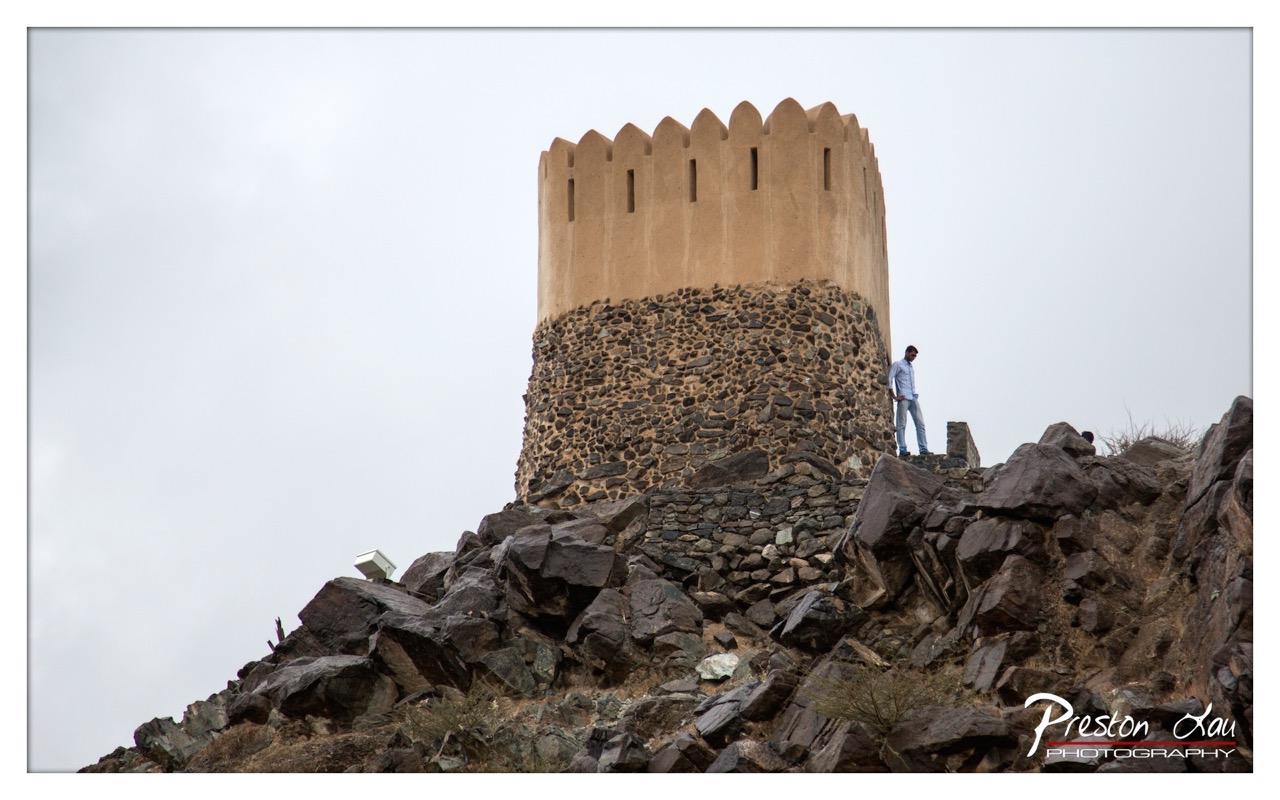

1. Overall Rating (0–10) — 7.0
This photograph captures a striking juxtaposition of ancient architecture and rugged natural terrain, with the historic tower standing as a silent sentinel against a muted sky. The low-angle perspective emphasizes the structure’s imposing presence, while the solitary figure adds a sense of scale and human connection to the past. Though the overcast lighting dampens the scene’s vibrancy, the image succeeds in conveying a quiet, contemplative mood that invites reflection on time and endurance.
2. Composition (0–10) — 7.5
The low-angle framing and diagonal placement of the rocky slope create a dynamic visual path leading to the tower, which is centered to command attention. The inclusion of the figure enhances balance and provides a narrative anchor, though the composition is slightly off-center due to the rocky foreground.
3. Lighting (0–10) — 5.5
Diffuse, overcast light flattens the scene’s tonal range, reducing texture and contrast in the stone and rock. While it ensures even exposure, the lack of directional light weakens the sense of depth and mood.
4. Color & Tone (0–10) — 6.0
The palette is restrained, dominated by earthy browns and grays that reflect the natural environment. The muted tones enhance the historical atmosphere but lack vibrancy, limiting emotional engagement.
5. Creativity (0–10) — 7.0
The image stands out for its strong narrative potential—blending architecture, landscape, and human presence into a cohesive story of heritage and solitude. The framing and perspective reflect thoughtful intent, elevating it beyond a simple documentation.
6. Technical Quality (0–10) — 8.0
The photograph is sharp and well-focused, with clean detail in both the stonework and the surrounding rocks. The exposure is balanced, and the image holds up well under scrutiny, despite the limitations of the lighting.
7. Emotional Impact (0–10) — 6.5
The scene evokes a sense of quiet awe and historical reverence, with the lone figure adding a touch of introspection. While the emotional resonance is strong, the subdued lighting tempers the intensity, leaving the viewer with a contemplative but not deeply stirring impression.
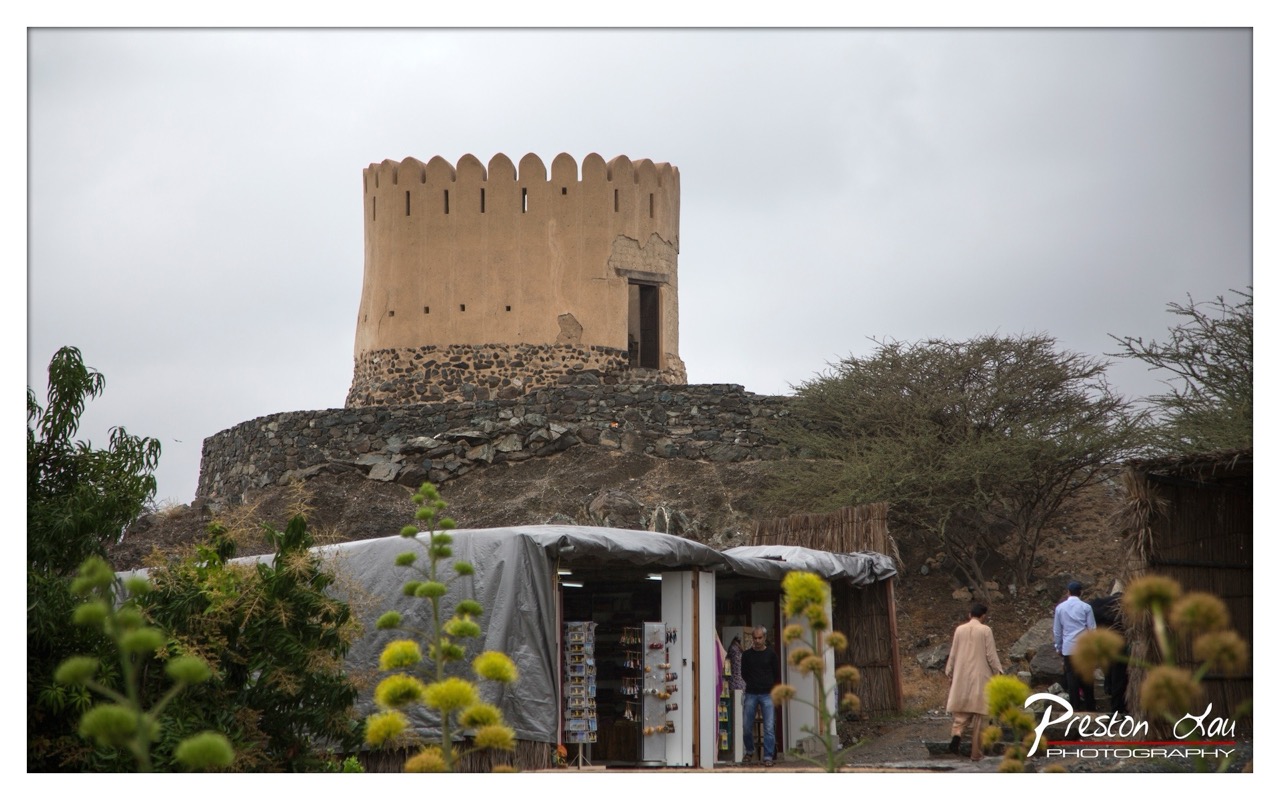

1. Overall Rating (0–10) — 6.8
This photograph captures a striking juxtaposition between ancient architecture and contemporary life, with the historic tower standing as a silent witness to the passage of time. The muted, overcast sky lends a somber tone, while the foreground market stall and visitors ground the scene in everyday reality. While the image successfully conveys a sense of place and cultural continuity, its emotional depth is slightly restrained by the flat lighting and busy composition, which distract from the tower’s architectural majesty.
2. Composition (0–10) — 6.0
The tower is centered and dominant, but the foreground elements—especially the out-of-focus flowers and the market stall—create visual clutter. A tighter crop would better emphasize the structure and enhance the sense of scale.
3. Lighting (0–10) — 5.5
The diffuse, overcast light softens shadows and minimizes texture, giving the image a flat quality. While it ensures even exposure, it also reduces the dramatic contrast that could highlight the tower’s stonework and historical weight.
4. Color & Tone (0–10) — 6.0
The palette is largely muted, dominated by earthy browns and grays, which suit the historical subject. However, the lack of vibrant color and the washed-out sky contribute to a subdued, almost melancholic tone that limits visual engagement.
5. Creativity (0–10) — 6.5
The image offers a thoughtful narrative by blending the ancient with the modern, suggesting a living history. The inclusion of people and a market stall adds layers of cultural context, though the approach is conventional rather than boldly interpretive.
6. Technical Quality (0–10) — 7.5
The focus is sharp on the tower and the people in the foreground, and the detail in the stonework is clear. The image is well-exposed, with no obvious technical flaws, though the depth of field could be more precisely managed.
7. Emotional Impact (0–10) — 6.0
The photograph evokes a quiet sense of timelessness and resilience, but the emotional resonance is muted by the lack of dramatic lighting and the visual distractions in the foreground. It invites contemplation rather than stirring a strong emotional response.
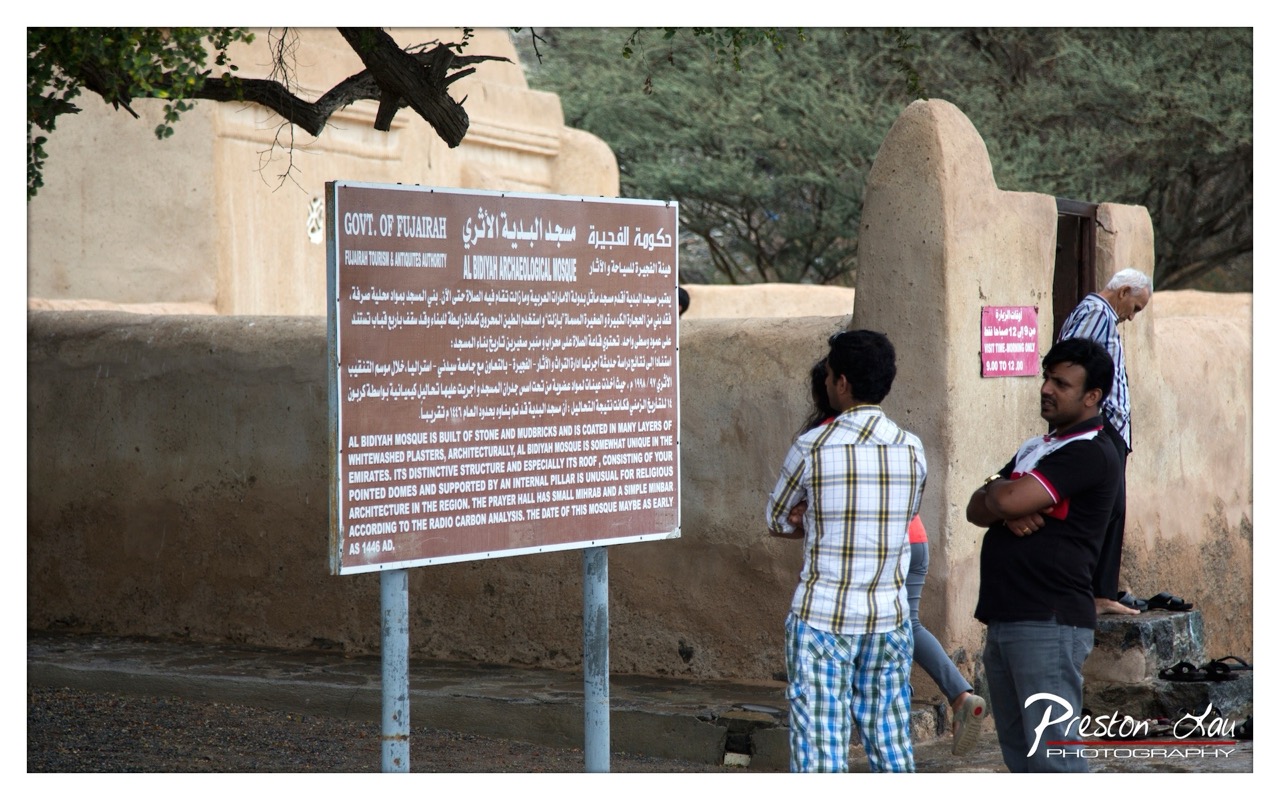

1. Overall Rating (0–10) — 6.8
This photograph captures a quiet moment of cultural observation at the Al Bidyah Archaeological Mosque, where history meets daily life. The juxtaposition of the informational sign with the casually dressed visitors creates a subtle narrative of heritage and modernity. While the image is grounded in authenticity, its visual impact is tempered by a slightly cluttered foreground and a lack of dynamic composition, which prevents it from fully conveying the site’s historical weight.
2. Composition (0–10) — 6.0
The sign dominates the left side, creating a strong visual anchor, but the placement of the figures on the right feels somewhat disjointed. The diagonal line of the tree branch adds visual interest, but the overall framing lacks balance, with too much empty space on the left and a crowded right side.
3. Lighting (0–10) — 6.5
Natural daylight provides even illumination, though it appears slightly overcast, flattening the texture of the mudbrick walls. The light is functional but not dramatic, failing to enhance the historical mood of the site.
4. Color & Tone (0–10) — 6.0
The palette is muted, dominated by earth tones—beige, brown, and gray—giving the image a subdued, documentary feel. The colors are accurate but lack vibrancy, contributing to a slightly lifeless atmosphere.
5. Creativity (0–10) — 6.5
The image is conceptually strong, blending cultural documentation with human presence. However, it leans more toward observational realism than artistic interpretation, with little effort to highlight the site’s unique architectural or spiritual qualities.
6. Technical Quality (0–10) — 7.0
The image is sharp and well-focused, particularly on the sign and the people in the foreground. The exposure is balanced, and there is minimal noise, indicating solid technical execution.
7. Emotional Impact (0–10) — 6.0
The photograph evokes a sense of quiet curiosity and respect for heritage, but the emotional resonance is restrained. The viewer is invited to observe, but not deeply moved—there’s a distance between the scene and the observer.
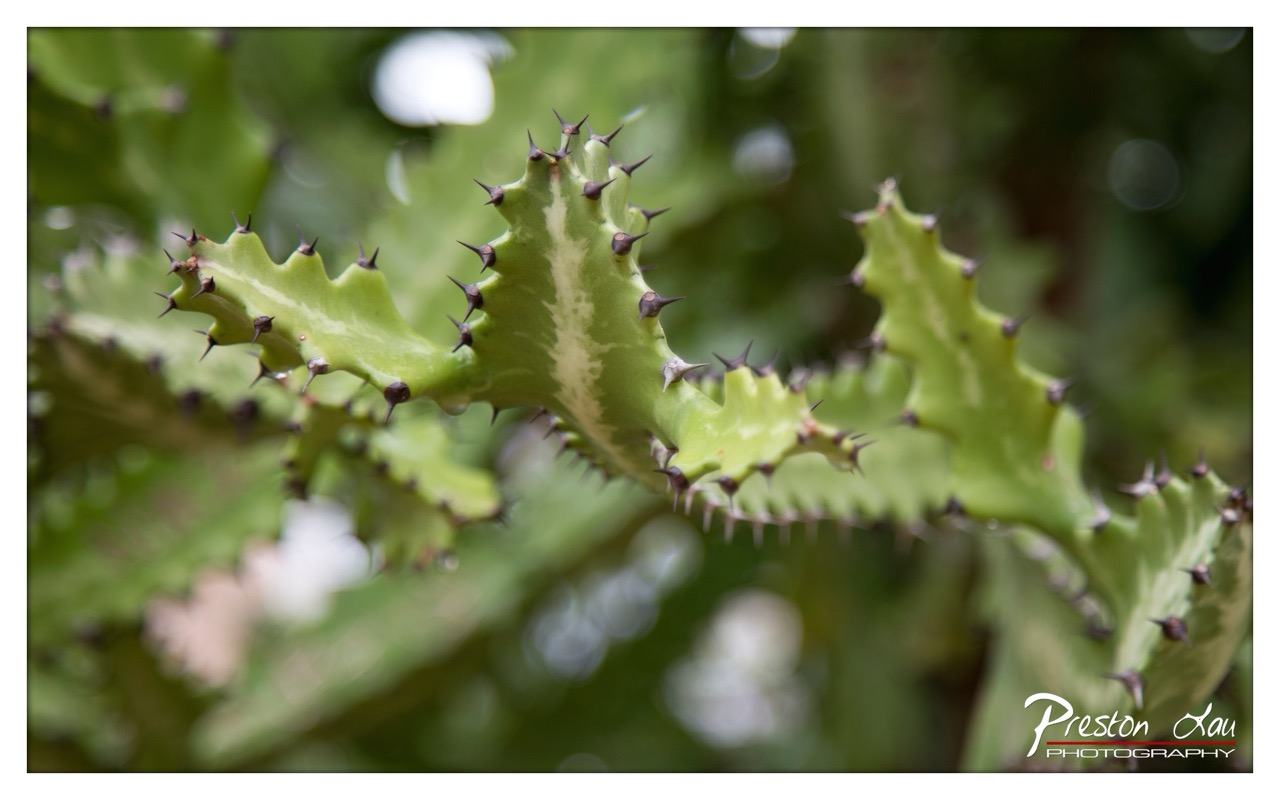

1. Overall Rating (0–10) — 7.5
This photograph captures the intricate texture and defiant beauty of a cactus, transforming a common plant into a study of form and resilience. The shallow depth of field draws attention to the spines and ridged structure, while the soft bokeh background adds a dreamlike quality. Though the image is visually compelling, it holds back slightly from full artistic impact due to a lack of dramatic lighting and a somewhat neutral color balance.
2. Composition (0–10) — 7.0
The diagonal placement of the cactus branch creates a dynamic flow, guiding the eye through the frame. The use of negative space on the left balances the composition, though the right side feels slightly crowded by the out-of-focus foliage.
3. Lighting (0–10) — 6.5
Soft, diffused light evenly illuminates the subject, highlighting the spines and ridges without harsh shadows. While the lighting is clean and natural, it lacks the contrast or directional drama that would heighten the image’s mood and dimension.
4. Color & Tone (0–10) — 6.0
The palette is dominated by various shades of green, with a subtle yellowish streak along the cactus’s center. The overall tone is muted and slightly flat, with a lack of vibrancy that keeps the image from feeling vivid or striking.
5. Creativity (0–10) — 7.5
The photographer’s choice to isolate the cactus with a shallow depth of field offers a fresh, macro-like perspective on a familiar subject. The interplay between sharp detail and soft background suggests a deliberate artistic intent to emphasize texture and form.
6. Technical Quality (0–10) — 8.0
The focus is sharp on the central cactus segment, with excellent clarity in the spines and surface texture. The image is free of noise, and the bokeh is smooth and well-rendered, indicating strong technical execution.
7. Emotional Impact (0–10) — 6.5
The image evokes a sense of quiet observation and appreciation for natural detail. While it invites contemplation of the plant’s resilience, the emotional resonance remains restrained, held back by the lack of a strong visual narrative or mood.
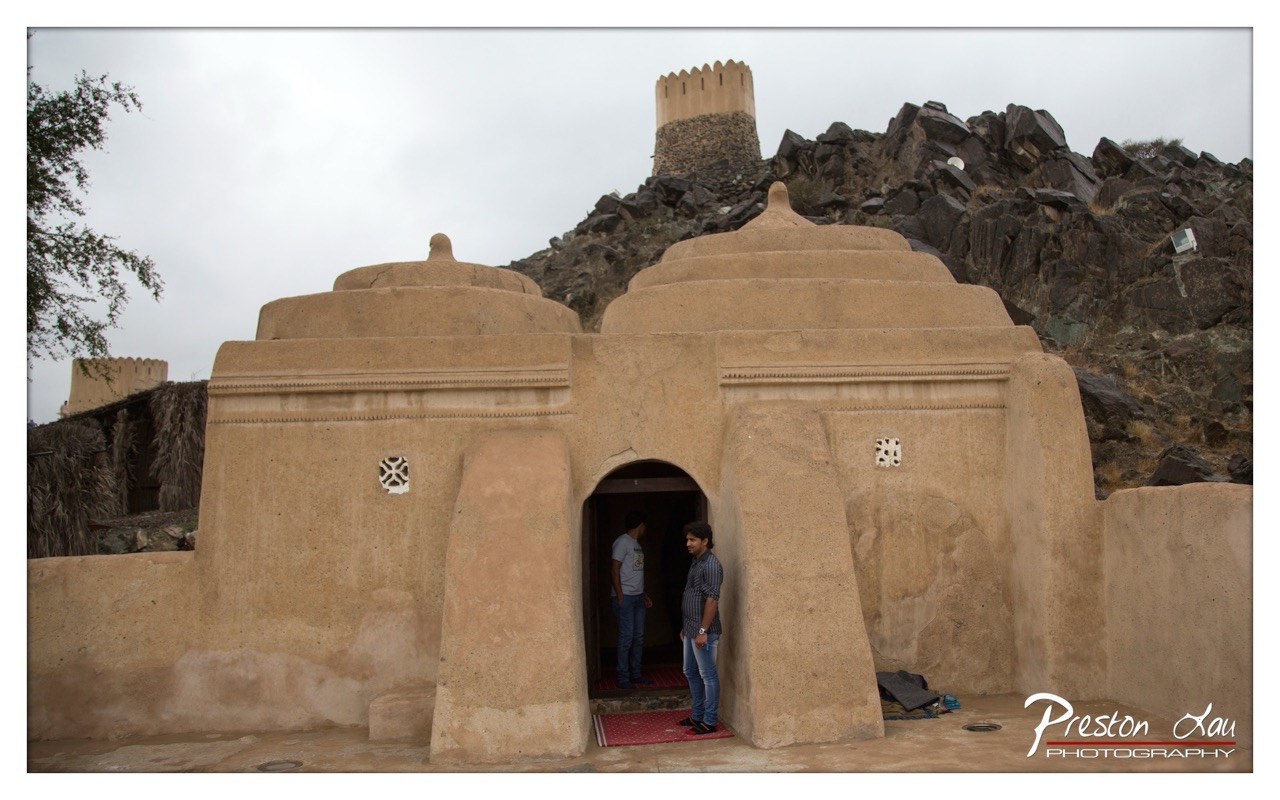

1. Overall Rating (0–10) — 7.0
This photograph captures a striking contrast between traditional mud-brick architecture and the rugged mountainous backdrop, evoking a sense of timelessness and cultural endurance. The two figures at the entrance add scale and narrative, grounding the scene in human experience. While the overcast sky dampens the warmth of the earth tones, the image’s strength lies in its ability to convey history and place through texture and form.
2. Composition (0–10) — 7.0
The symmetrical placement of the domed structure anchors the frame, while the inclusion of the men at the entrance provides a natural focal point. The rocky hill and distant tower add depth and context, creating a layered visual narrative.
3. Lighting (0–10) — 5.5
The diffuse, overcast light softens textures and minimizes shadows, lending a muted, contemplative mood. While it prevents dramatic highlights, it enhances the tactile quality of the mud walls.
4. Color & Tone (0–10) — 6.0
The palette is dominated by earthy tans and grays, with subtle contrast from the red rug and the dark clothing of the figures. The lack of vibrant color limits visual excitement but reinforces the scene’s authenticity and restraint.
5. Creativity (0–10) — 6.5
The image succeeds in documenting a culturally rich environment with a quiet sense of dignity. While not overtly experimental, it tells a story through its juxtaposition of architecture, landscape, and human presence.
6. Technical Quality (0–10) — 7.5
The image is sharp and well-focused, with clear detail in the texture of the mud walls. The exposure is balanced, though slight underexposure in the doorway slightly obscures the interior.
7. Emotional Impact (0–10) — 6.5
There’s a quiet reverence in the scene—rooted in history and resilience—that invites reflection. The presence of the figures adds a personal touch, making the ancient structure feel accessible and alive.
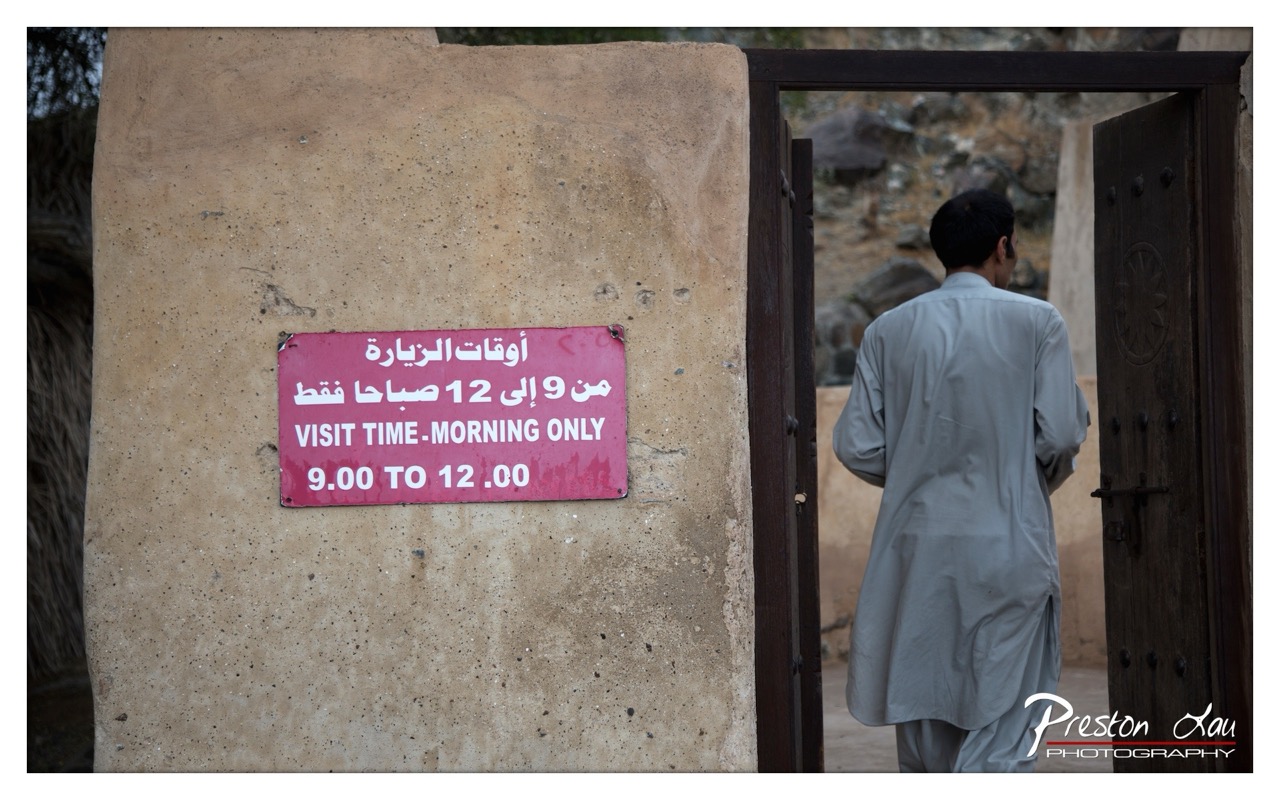

1. Overall Rating (0–10) — 7.0
This photograph captures a quiet moment of cultural transition, where tradition meets regulation in a single frame. The juxtaposition of the man entering a rustic doorway and the bold sign declaring restricted visitation creates a subtle tension between daily life and institutional control. While the composition is balanced and the subject matter compelling, the image’s emotional weight is slightly diminished by the lack of dynamic lighting and the somewhat abrupt framing.
2. Composition (0–10) — 7.0
The man is positioned off-center, leading the eye into the doorway, while the sign anchors the left side, creating visual balance. The vertical lines of the wall and door frame the scene effectively, though the framing feels slightly tight, cutting off some context.
3. Lighting (0–10) — 6.0
Natural daylight illuminates the scene evenly, but the flatness of the light reduces depth and shadow definition. The overcast quality of the light softens textures, which, while clear, doesn’t add dramatic contrast or mood.
4. Color & Tone (0–10) — 6.5
The muted earth tones of the wall and the man’s gray kurta harmonize with the environment, while the red sign provides a strong visual contrast. The color palette feels authentic and grounded, though the saturation is restrained, giving the image a documentary quality.
5. Creativity (0–10) — 7.0
The image succeeds in blending narrative and observation, using the sign as a narrative device to suggest time, place, and cultural norms. The back view of the man invites curiosity about his destination, adding a layer of storytelling.
6. Technical Quality (0–10) — 7.5
The image is sharp and well-focused, with clear detail in both the sign and the textures of the wall and door. The watermark is subtle and does not detract from the composition.
7. Emotional Impact (0–10) — 6.5
The photograph evokes a sense of quiet contemplation and cultural specificity, inviting viewers to reflect on the intersection of routine and restriction. While the emotion is restrained, the narrative depth offers room for personal interpretation.
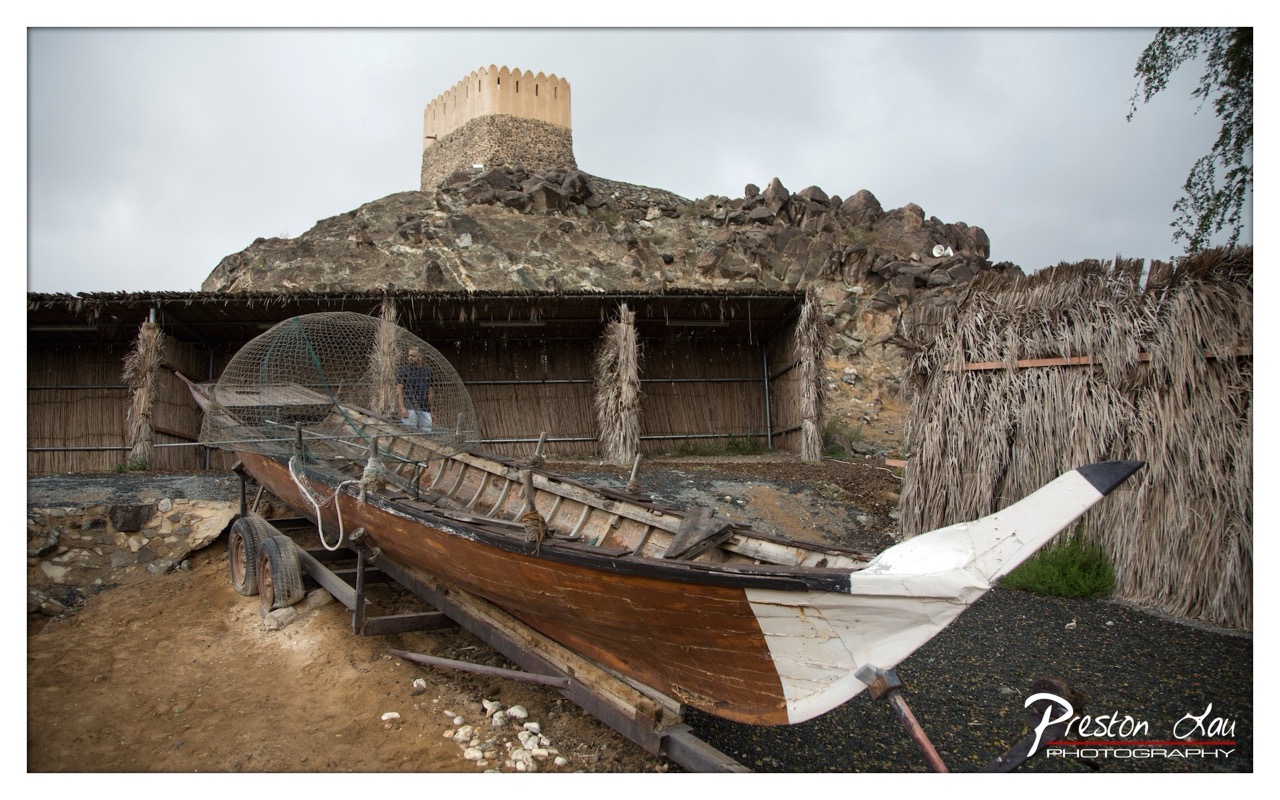

1. Overall Rating (0–10) — 7.0
This photograph captures a striking juxtaposition of traditional maritime life and ancient architecture, evoking a sense of cultural continuity and historical depth. The weathered dhow, resting on a trailer beneath a thatched shelter, serves as a powerful symbol of heritage, while the fortress rising from the rocky hilltop anchors the scene in time and place. While the overcast sky dampens the mood and the composition feels slightly cluttered, the image succeeds in conveying a quiet narrative of resilience and tradition, with its authenticity lending it a compelling, documentary-like quality.
2. Composition (0–10) — 6.0
The dhow is placed off-center, creating a dynamic diagonal that draws the eye across the frame, but the surrounding elements—particularly the overhanging thatch and scattered debris—distract from the main subject. The fortress in the background provides a strong focal point, yet the visual weight of the foreground objects slightly overwhelms the scene, reducing compositional harmony.
3. Lighting (0–10) — 5.5
The diffuse, overcast light flattens the scene, muting textures and reducing contrast. While this soft light prevents harsh shadows and allows for even detail across the wooden boat and stone structure, it also diminishes the atmospheric drama, giving the image a somewhat muted and lifeless quality.
4. Color & Tone (0–10) — 6.0
The palette is dominated by earthy browns, muted grays, and the faded white of the dhow’s bow, creating a cohesive, naturalistic tone. However, the lack of vibrancy and the absence of color contrast limit the image’s visual impact, making it feel more documentary than artistic.
5. Creativity (0–10) — 7.5
The image stands out for its strong narrative potential—blending cultural artifacts with historical architecture to tell a story of tradition and endurance. The inclusion of the person in the background adds a subtle human element, enhancing the sense of lived history, while the framing suggests a deliberate effort to contextualize the dhow within its environment.
6. Technical Quality (0–10) — 7.5
The image is sharp and well-focused, with clear detail visible in the wood grain of the dhow and the texture of the stone fortress. The exposure is balanced, and the depth of field is appropriate, keeping both foreground and background in focus. The watermark is professionally placed and does not detract from the image.
7. Emotional Impact (0–10) — 6.5
The photograph evokes a contemplative, nostalgic mood, inviting the viewer to reflect on the passage of time and the preservation of cultural identity. While the emotional resonance is tempered by the flat lighting and busy foreground, the subject matter itself carries a quiet dignity that lingers.
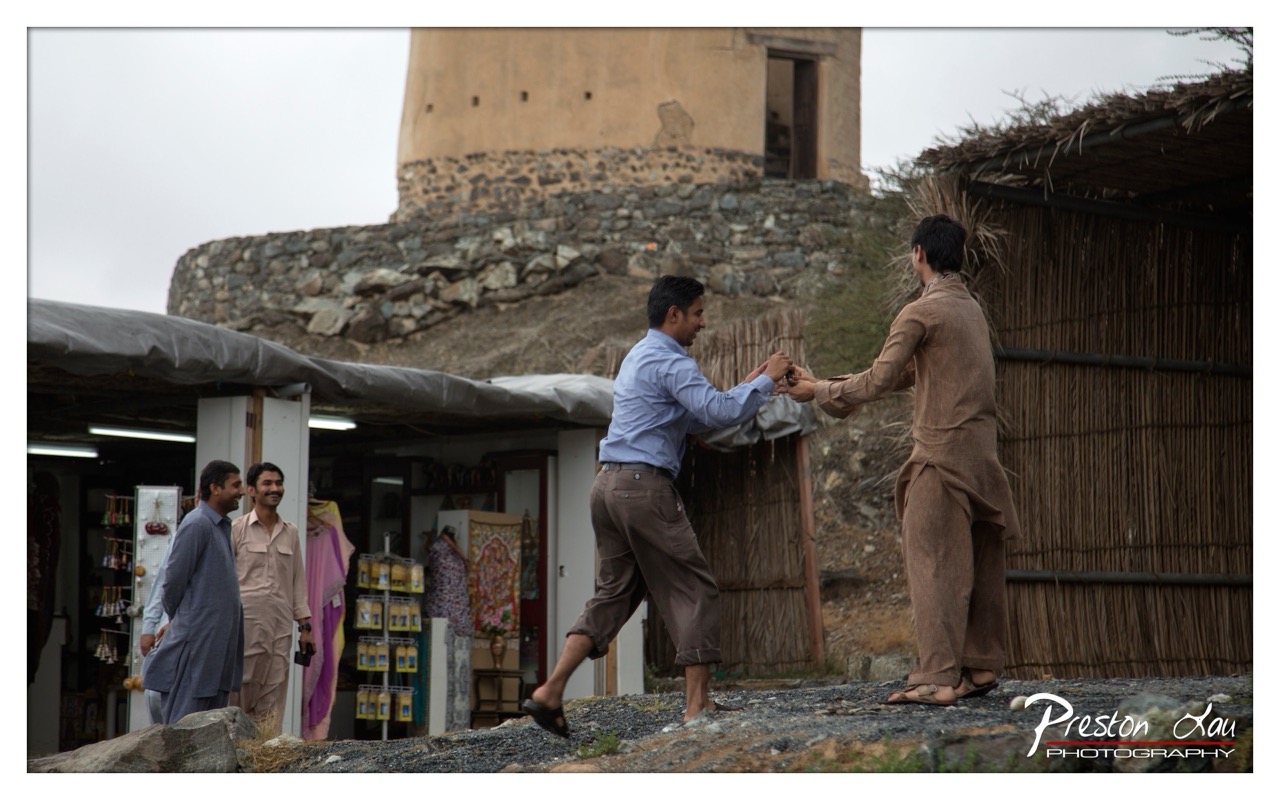

1. Overall Rating (0–10) — 7.0
This photograph captures a candid moment of cultural exchange, where two men in traditional attire engage in a handshake against the backdrop of a rustic, historic setting. The scene feels authentic and grounded, with the weathered stone tower and thatched structures adding depth and context. While the image successfully conveys a sense of place and human connection, the overcast lighting and slightly cluttered background temper its visual impact, keeping it from feeling fully cinematic or emotionally resonant.
2. Composition (0–10) — 6.5
The subjects are well-framed and positioned along a diagonal line, guiding the viewer’s eye through the scene. However, the presence of the two onlookers on the left and the visible shop interior slightly distract from the central interaction, creating a busy foreground that competes for attention.
3. Lighting (0–10) — 5.5
The overcast sky provides soft, diffused light that minimizes harsh shadows, allowing for even exposure across the scene. However, the lack of directional light and contrast results in a muted, flat quality that diminishes the visual drama.
4. Color & Tone (0–10) — 6.0
The palette is dominated by earthy tones—browns, tans, and muted grays—that harmonize with the environment. While the colors are natural and appropriate, they lack vibrancy and richness, giving the image a subdued, almost documentary-like feel.
5. Creativity (0–10) — 7.0
The photograph succeeds in capturing a genuine cultural moment with an observational, street-photography style. The interplay between tradition and modernity—evident in the clothing and setting—adds narrative depth, and the candid nature of the exchange enhances its authenticity.
6. Technical Quality (0–10) — 7.5
The image is sharp and well-focused, with clear details in both the foreground and background. The exposure is balanced, and the depth of field appropriately isolates the main subjects while maintaining context.
7. Emotional Impact (0–10) — 6.5
The handshake and shared smiles evoke a sense of warmth and mutual respect, suggesting a moment of connection or agreement. While the emotion is present, the lack of dynamic lighting and compositional focus keeps the viewer from fully immersing in the scene’s emotional core.
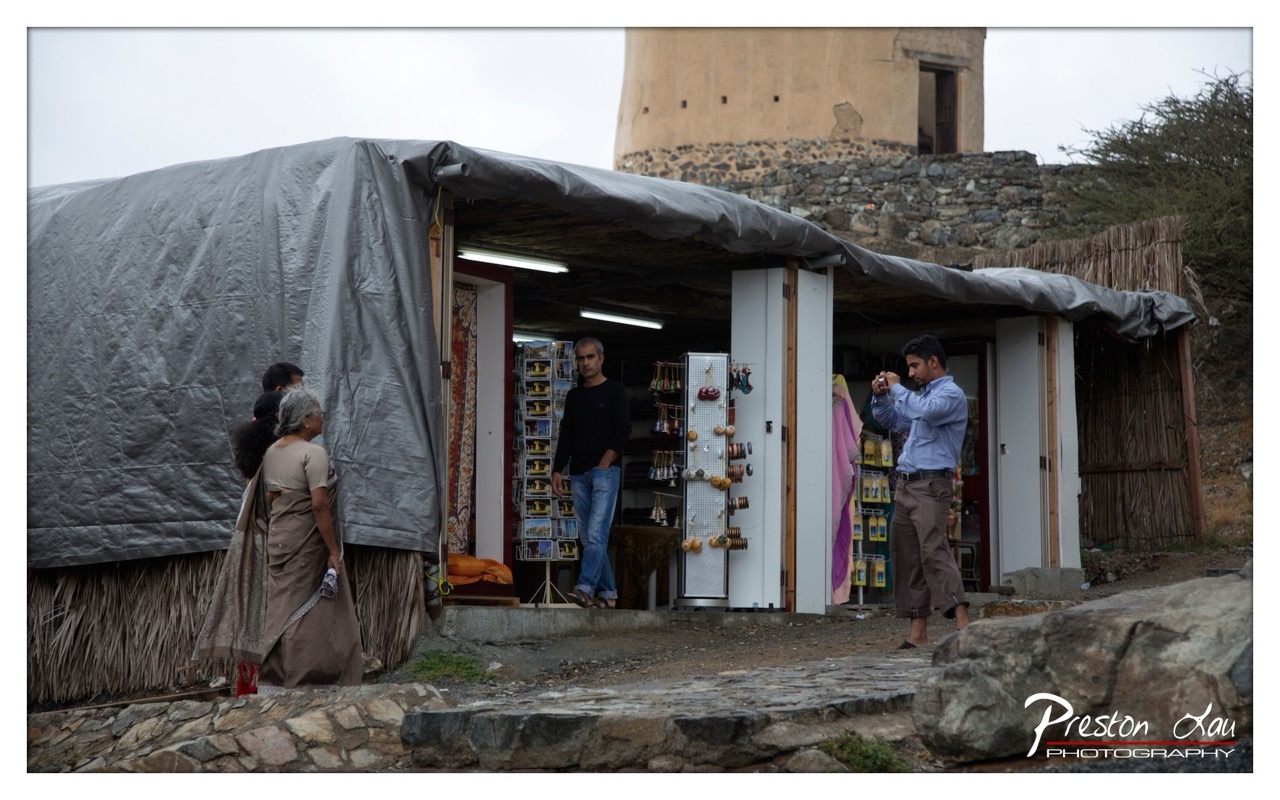

1. Overall Rating (0–10) — 6.8
This photograph captures a quiet, candid moment at a roadside souvenir stall, where tradition and commerce intersect under a makeshift canopy. The juxtaposition of the rustic stone tower in the background with the modern tarp and fluorescent lighting creates a layered narrative of cultural continuity and adaptation. While the scene is rich in context, the flat lighting and slightly cluttered composition prevent it from achieving a more compelling visual rhythm.
2. Composition (0–10) — 6.0
The frame is anchored by the large tarp on the left, which creates a strong diagonal but also dominates the visual space, pulling focus away from the central figures. The placement of the people—some observing, one actively taking a photo—adds narrative depth, but the composition feels slightly unbalanced due to the uneven distribution of visual weight.
3. Lighting (0–10) — 5.5
The overcast sky casts a diffused, flat light that minimizes shadows and reduces atmospheric depth. While the fluorescent lights inside the stall provide some illumination, they do little to enhance the mood, resulting in a neutral, documentary feel rather than a cinematic one.
4. Color & Tone (0–10) — 6.0
The color palette is muted, with earthy tones dominating the scene—browns, grays, and faded pastels. The lack of vibrant color tempers the image’s visual appeal, though the subtle contrast between the bright white stall interior and the darker surroundings adds a touch of visual interest.
5. Creativity (0–10) — 7.0
The image succeeds in capturing a slice of daily life with authenticity, and the inclusion of the man photographing the scene introduces a meta-narrative that adds depth. The blend of old and new architectural elements suggests a story of cultural preservation, lending a thoughtful and layered quality to the work.
6. Technical Quality (0–10) — 7.5
The image is sharp and clear, with good detail in both the foreground and background. Focus is consistent across the frame, and the exposure is well-managed, avoiding blown highlights or lost shadows despite the challenging lighting conditions.
7. Emotional Impact (0–10) — 6.5
There’s a quiet dignity in the scene—people going about their day, a vendor at ease, a woman in traditional attire passing by. The emotional resonance lies in its authenticity and the sense of place, though the lack of dramatic lighting or strong composition keeps the viewer from fully connecting with the moment.
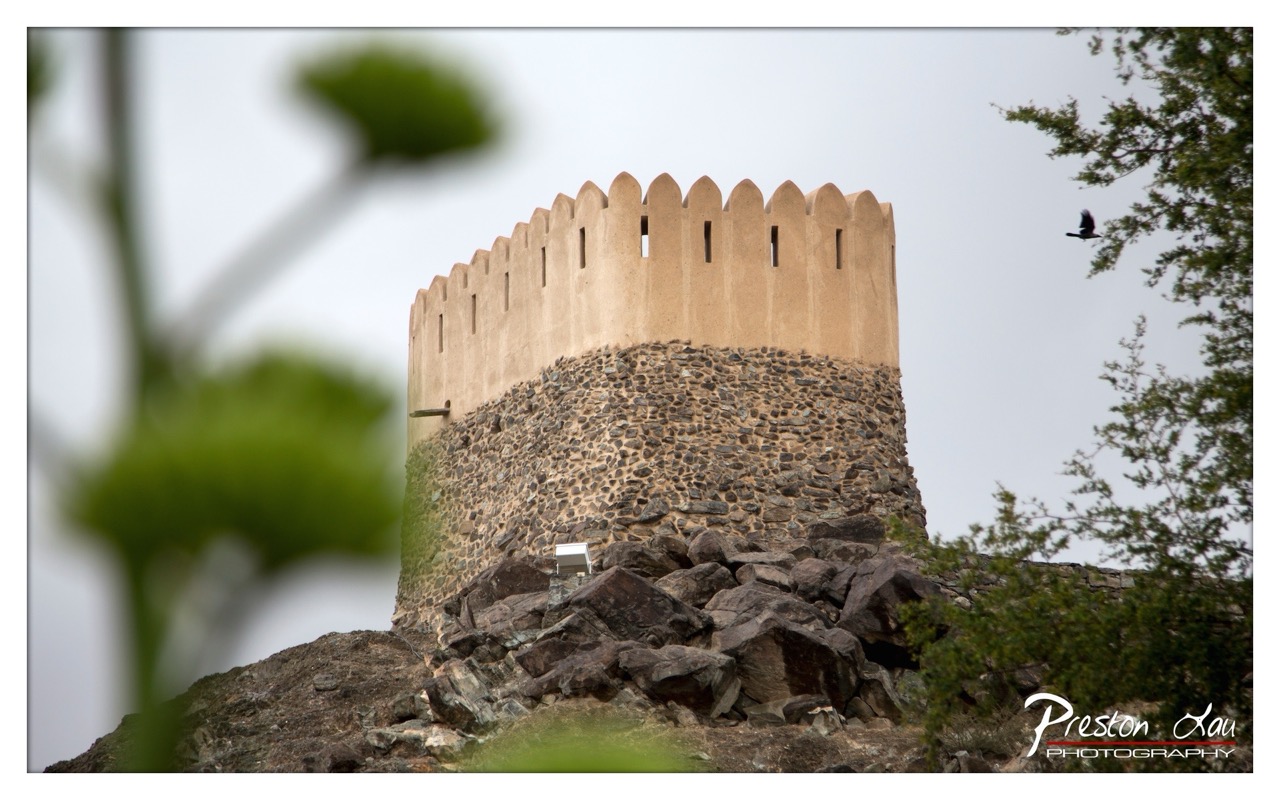

1. Overall Rating (0–10) — 7.0
This photograph captures the timeless presence of a traditional Middle Eastern fortification, blending ancient architecture with the quiet vitality of nature. The use of foreground blur and a lone bird in flight adds a layer of motion and narrative, evoking a sense of timelessness and solitude. While the muted lighting and slightly overcast sky temper the image’s visual drama, the composition successfully frames the tower as both a historical monument and a living part of its landscape.
2. Composition (0–10) — 7.5
The tower is well-centered, with the blurred foliage on the left creating a natural frame that draws the eye toward the subject. The bird in the upper right adds balance and a sense of scale, though the foreground elements slightly distract from the tower’s full presence.
3. Lighting (0–10) — 5.5
The overcast sky produces soft, diffused light that minimizes harsh shadows, enhancing texture in the stone but also flattening the overall tonal range. The lack of directional light limits depth and mood.
4. Color & Tone (0–10) — 6.0
The palette is restrained, dominated by earthy tones—beige, gray, and muted green—that reflect the natural environment. The lack of vibrancy tempers the image’s emotional pull, though the subtle contrast between the warm stone and cool foliage adds slight visual interest.
5. Creativity (0–10) — 7.0
The photographer employs a thoughtful use of depth of field and natural framing to create a layered, contemplative image. The inclusion of the bird introduces a dynamic element, transforming a static scene into a moment of quiet narrative.
6. Technical Quality (0–10) — 8.0
The focus on the tower is sharp and clear, with fine detail visible in the stonework. The lens flare is minimal, and the image is well-exposed, with no obvious technical flaws.
7. Emotional Impact (0–10) — 6.5
The image evokes a quiet reverence for history and place, with a sense of solitude that resonates emotionally. While not overtly dramatic, it invites reflection on time, endurance, and the intersection of nature and human legacy.
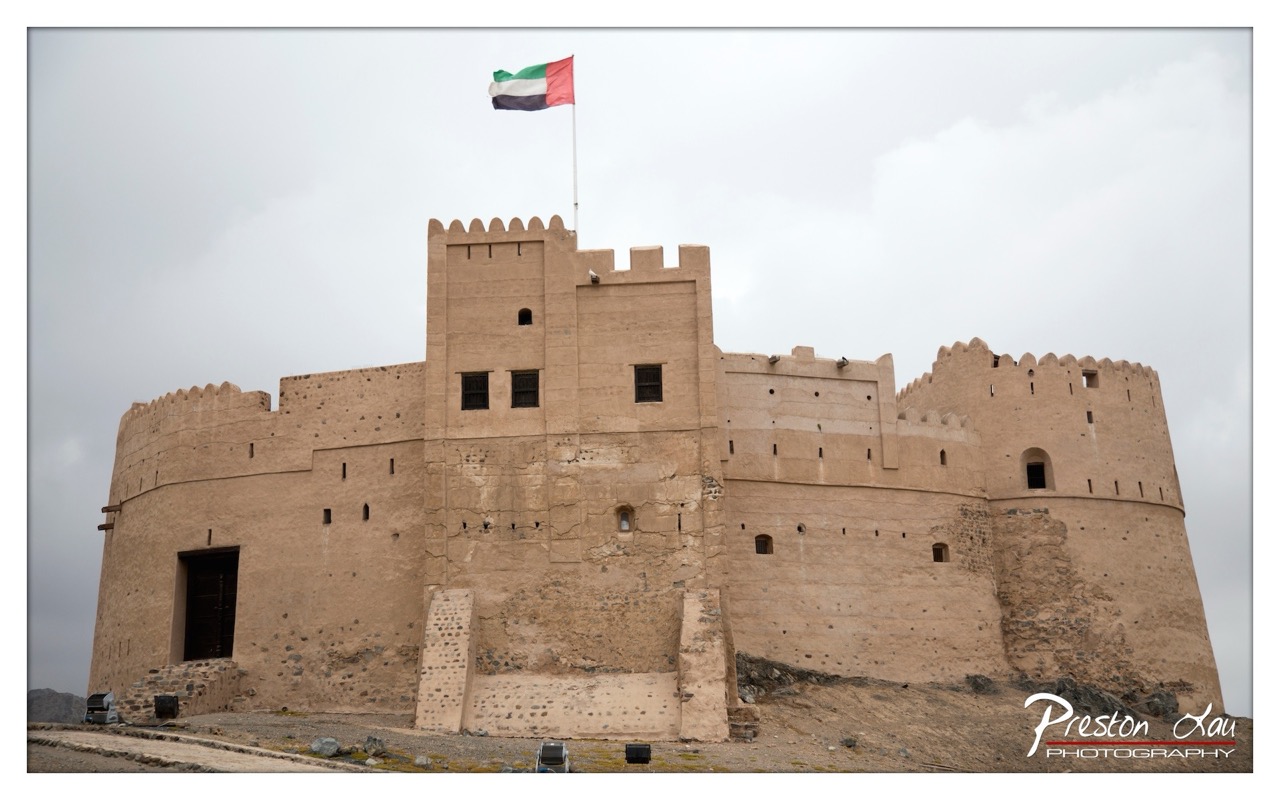

1. Overall Rating (0–10) — 7.0
This photograph captures the stoic grandeur of a traditional Emirati fort under a brooding sky, with the national flag asserting a quiet pride atop its battlements. The weathered stone and imposing silhouette convey a sense of historical resilience, while the muted palette and overcast light lend a contemplative, almost solemn tone. While the image is strong in its documentary clarity and cultural resonance, it lacks the dynamic lighting or compositional drama to elevate it beyond a competent travel portrait.
2. Composition (0–10) — 6.5
The fort is centered with a slight tilt, giving a sense of stability but also a subtle imbalance. The low angle emphasizes the structure’s scale, though the inclusion of foreground elements like the small vehicles slightly disrupts the visual harmony.
3. Lighting (0–10) — 5.5
The overcast sky provides soft, even light that minimizes harsh shadows and reveals texture in the stone. However, the lack of directional light or contrast limits depth and mood, resulting in a somewhat flat and muted atmosphere.
4. Color & Tone (0–10) — 6.0
The palette is restrained, dominated by earthy beiges and grays, with the flag providing a modest burst of color. The tonal range is narrow, and while it suits the somber mood, it lacks vibrancy and visual punch.
5. Creativity (0–10) — 6.5
The image successfully captures a moment of cultural heritage with straightforward clarity, but it leans more toward documentation than artistic interpretation. The choice to include the flag adds symbolic weight, but the overall approach remains conventional.
6. Technical Quality (0–10) — 8.0
The image is sharp and well-focused, with clear detail in the fort’s stonework and a clean exposure. The watermark is professionally placed and does not detract from the composition.
7. Emotional Impact (0–10) — 6.5
The photograph evokes a sense of quiet reverence and historical continuity, but the lack of dramatic lighting and emotional intensity keeps the viewer at a respectful distance rather than drawing them into a deeper emotional engagement.
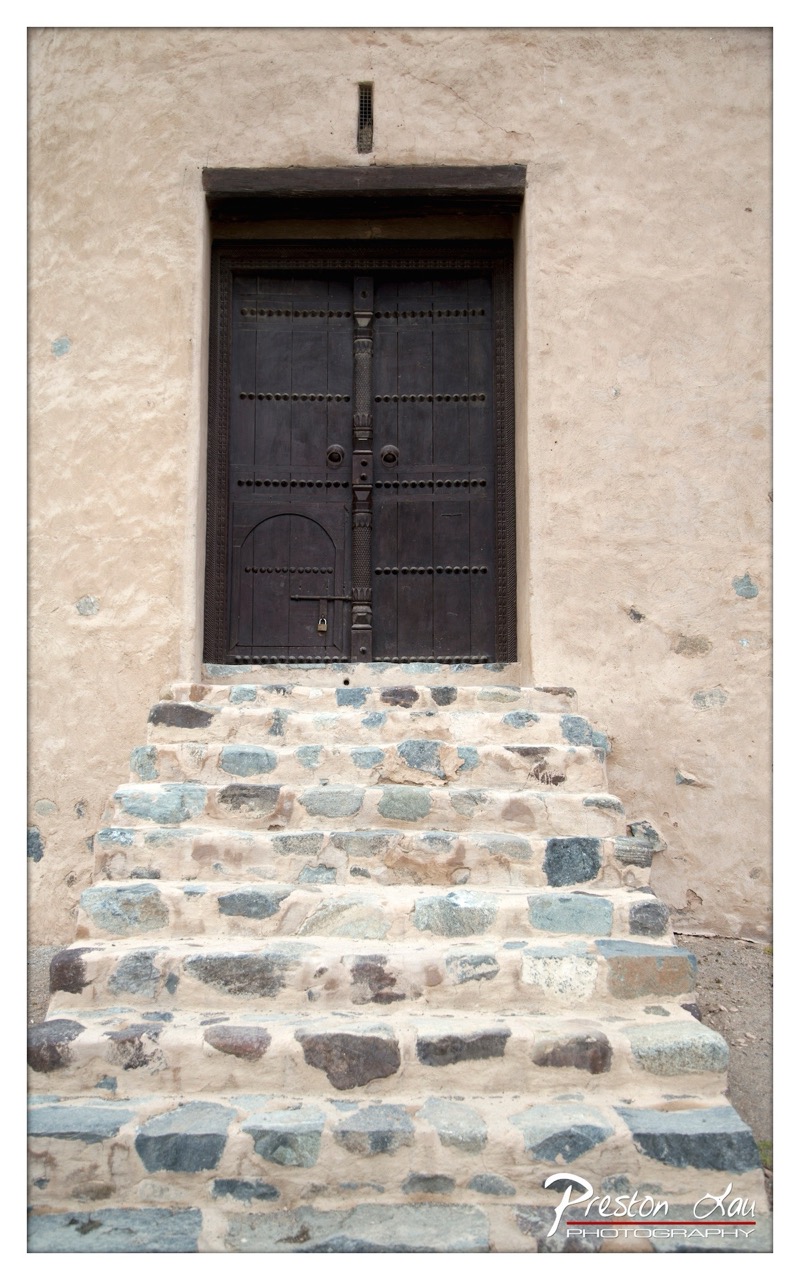

1. Overall Rating (0–10) — 7.0
This photograph captures the quiet dignity of a traditional doorway, where history and craftsmanship meet in a moment of stillness. The contrast between the weathered stone steps and the ornate wooden door creates a compelling narrative of age and resilience. While the composition is strong and the subject compelling, the flat lighting and muted tones slightly temper the image’s emotional pull, leaving it more observational than evocative.
2. Composition (0–10) — 7.5
The centered framing draws the eye directly to the door, emphasizing its architectural significance. The diagonal progression of the steps adds subtle movement, guiding the viewer upward toward the entrance, though the symmetry slightly limits dynamic tension.
3. Lighting (0–10) — 6.0
Even, diffused light illuminates the scene without harsh shadows, preserving detail in both the door and the stonework. However, the lack of directional contrast or dramatic highlights gives the image a somewhat flat, documentary feel.
4. Color & Tone (0–10) — 6.5
The palette is restrained—earthy beiges, muted grays, and deep browns—creating a cohesive, timeless mood. While harmonious, the lack of vibrancy limits visual excitement, reinforcing the image’s quiet, understated character.
5. Creativity (0–10) — 7.0
The photograph succeeds in capturing the cultural and architectural essence of the location, using composition and texture to tell a story of tradition. Its strength lies in its authenticity rather than bold artistic invention.
6. Technical Quality (0–10) — 8.0
Sharp focus throughout, clean detail in the wood grain and stone texture, and a well-executed exposure ensure the image holds up technically, even if it lacks visual flair.
7. Emotional Impact (0–10) — 6.5
There is a quiet sense of reverence and permanence, inviting contemplation of the past. Yet, the image feels more like a record than an emotional invitation, keeping the viewer in a position of detached observation.
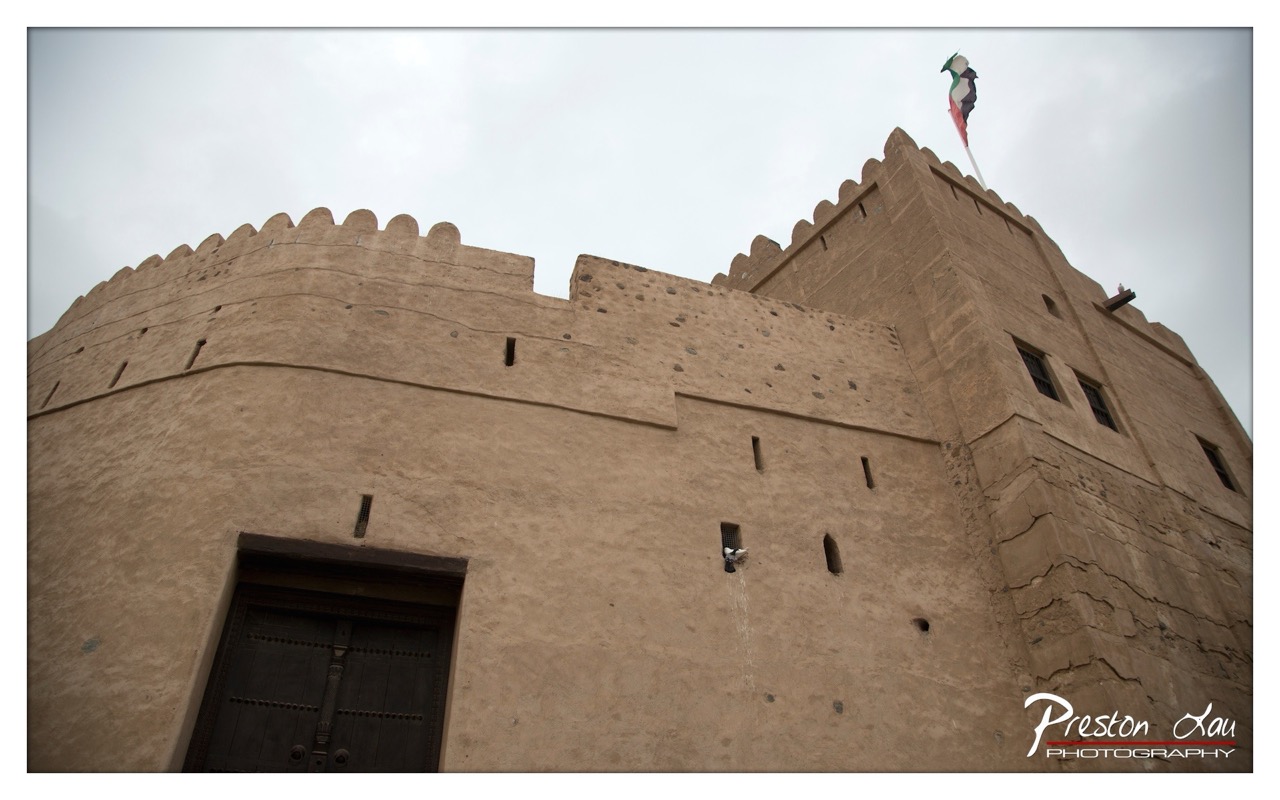

1. Overall Rating (0–10) — 7.0
This photograph captures the imposing presence of a traditional Middle Eastern fort with a sense of historical gravitas, its weathered mud-brick walls speaking of resilience and time. The low-angle perspective enhances the monumentality of the structure, while the fluttering flag adds a subtle touch of national pride. The muted tones and overcast sky lend a somber, contemplative mood, though the image could benefit from more dynamic contrast to fully bring out the texture of the walls.
2. Composition (0–10) — 7.0
The low-angle shot emphasizes the fort’s scale and verticality, with the curved wall and crenellated parapet guiding the eye toward the flag. The placement of the dark wooden door on the left creates a strong visual anchor, while the diagonal line of the structure adds depth and movement.
3. Lighting (0–10) — 6.0
The diffuse, overcast light softens shadows and evenly illuminates the scene, preserving texture in the walls but resulting in a somewhat flat appearance. The lack of directional light reduces the sense of drama, though it does allow for clear visibility of architectural details.
4. Color & Tone (0–10) — 6.5
The earthy, monochromatic palette of tans and browns is fitting for the subject, conveying a sense of age and place. However, the colors lack vibrancy, and the overall tone leans slightly cool, which dampens the warmth one might expect from such a sun-drenched region.
5. Creativity (0–10) — 7.0
The choice of a low-angle perspective and the inclusion of the flag elevate the image beyond a simple architectural record, transforming it into a narrative of heritage and continuity. The subtle inclusion of the bird and water stream adds a quiet, poetic detail.
6. Technical Quality (0–10) — 7.5
Sharp focus is maintained across the frame, with clear detail visible in the texture of the walls and the wooden door. The exposure is well-balanced, and the watermark is discreet, preserving the image’s integrity.
7. Emotional Impact (0–10) — 7.0
The image evokes a sense of reverence for history and tradition, with the fort standing as a silent guardian of the past. The quiet atmosphere invites reflection, and the viewer is drawn into a moment of stillness and timelessness.
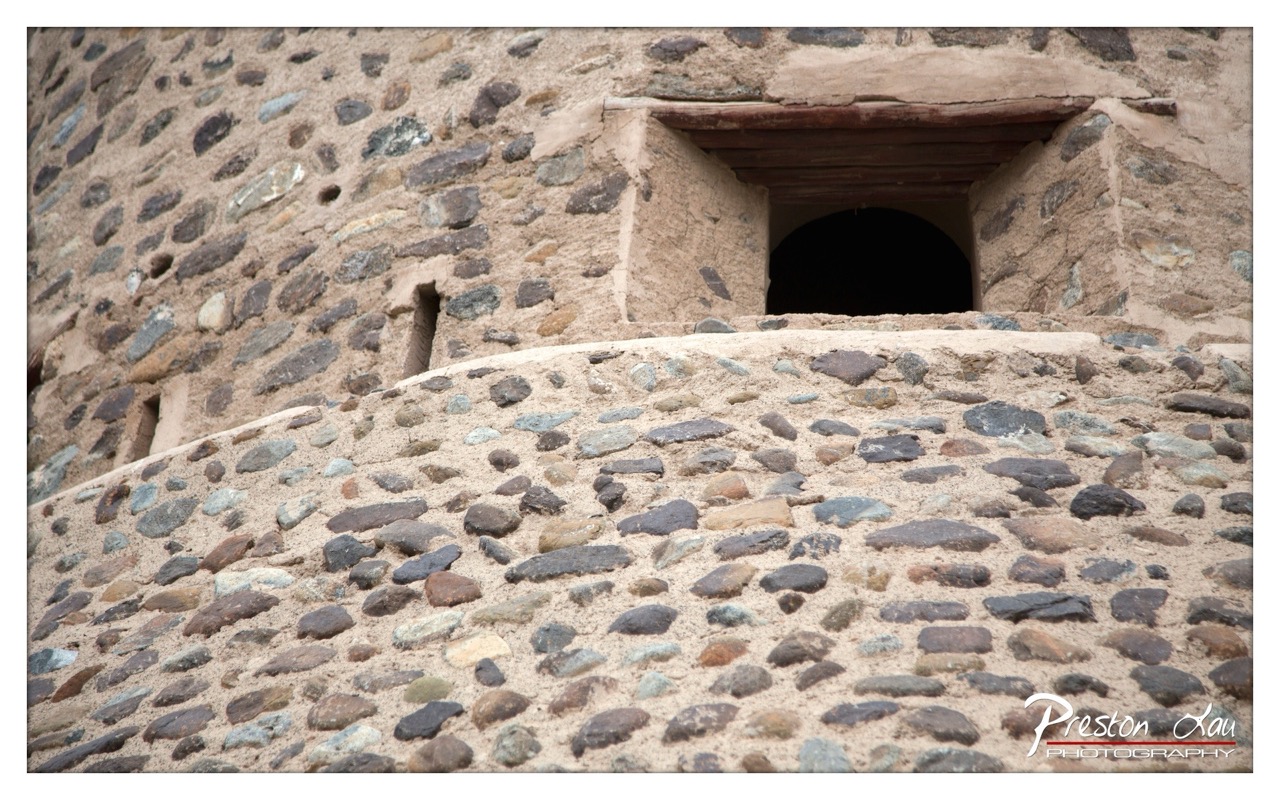

1. Overall Rating (0–10) — 7.0
This photograph captures the rugged texture and historical weight of a traditional stone structure, evoking a sense of timelessness and endurance. The interplay of light and shadow across the uneven stonework creates a tactile quality that invites closer inspection. While the image is visually rich in detail, its muted color palette and lack of a strong focal point slightly diminish its emotional pull, leaving it more as an observation than an experience.
2. Composition (0–10) — 6.5
The low-angle perspective emphasizes the curvature and scale of the stonework, drawing the eye toward the dark, arched opening. The placement of the doorway slightly off-center adds visual interest, though the foreground’s expansive texture risks overwhelming the subject.
3. Lighting (0–10) — 6.0
Natural daylight highlights the texture of the stones, but the flat, diffuse quality of the light softens contrast and reduces depth. The deep shadow within the arch provides a strong visual anchor, yet the overall illumination lacks dramatic tension.
4. Color & Tone (0–10) — 6.0
The palette is dominated by earthy tones—beiges, grays, and muted browns—that reflect the materiality of the structure. While cohesive, the lack of vibrancy gives the image a subdued, almost monochromatic feel that limits its visual impact.
5. Creativity (0–10) — 7.0
The photographer captures a moment of quiet architectural beauty, focusing on texture and form rather than narrative. The choice to frame the shot through the foreground curve adds a subtle layer of compositional ingenuity, inviting the viewer to explore the surface as much as the structure.
6. Technical Quality (0–10) — 7.5
The image is sharp and well-focused, with fine detail visible in the stones and mortar. The resolution is high, and the watermark is discreet, preserving the integrity of the composition.
7. Emotional Impact (0–10) — 6.5
The photograph conveys a sense of stillness and permanence, evoking contemplation of the past. While it doesn’t elicit strong emotion, its quiet dignity resonates with those attuned to the beauty of aged, hand-built architecture.
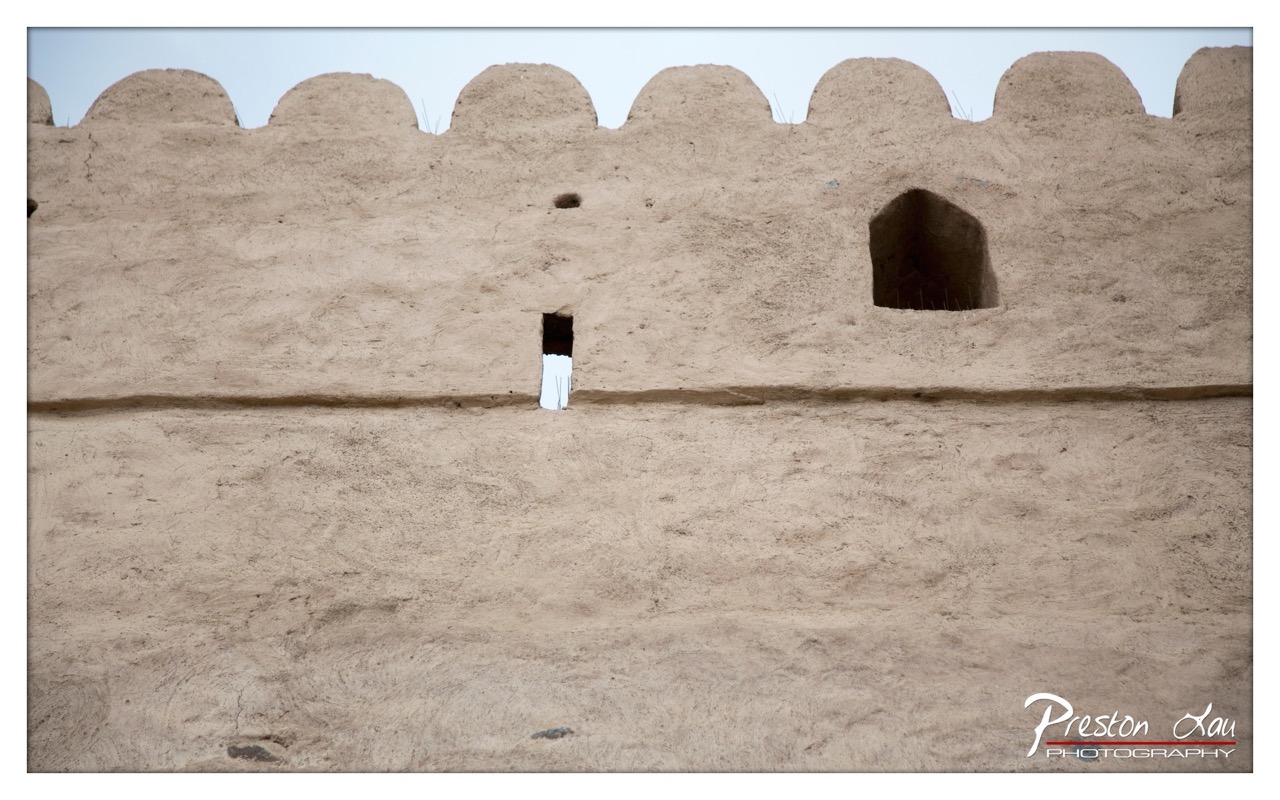

1. Overall Rating (0–10) — 7.0
This photograph captures the quiet dignity of ancient mud-brick architecture, where texture and form speak of enduring tradition and resilience. The stark simplicity of the wall, punctuated by a narrow window and arched opening, evokes a sense of timelessness and solitude. While the image is visually compelling in its minimalism, the muted lighting and lack of dynamic contrast slightly limit its emotional reach.
2. Composition (0–10) — 7.5
The horizontal line of the wall divides the frame cleanly, creating a balanced and structured composition. The placement of the small window and arched opening introduces asymmetry that draws the eye, while the crenellated top edge adds rhythmic repetition, enhancing visual harmony.
3. Lighting (0–10) — 6.0
The light is soft and diffused, likely from an overcast sky, which flattens the depth of the wall’s texture. While it prevents harsh shadows, it also reduces the tactile quality of the mud surface, making the image feel somewhat muted.
4. Color & Tone (0–10) — 6.5
The monochromatic earth tones—beige, tan, and subtle brown—create a cohesive and natural palette. The lack of vibrant color supports the image’s quiet mood, though a slight increase in warmth could enhance the sense of age and sun-baked history.
5. Creativity (0–10) — 7.0
The photographer emphasizes form and texture over narrative, presenting a contemplative study of architectural detail. The juxtaposition of the man-made openings against the organic surface invites reflection on human presence within a timeless structure.
6. Technical Quality (0–10) — 8.0
The image is sharp and well-focused, with fine detail visible in the wall’s surface. The clean white border and watermark add a professional touch, and the overall clarity supports the photograph’s textural intent.
7. Emotional Impact (0–10) — 6.5
The image conveys a quiet reverence for ancient craftsmanship and the passage of time, but the subdued lighting and lack of human presence keep the emotional connection at a distance, making it more observational than evocative.
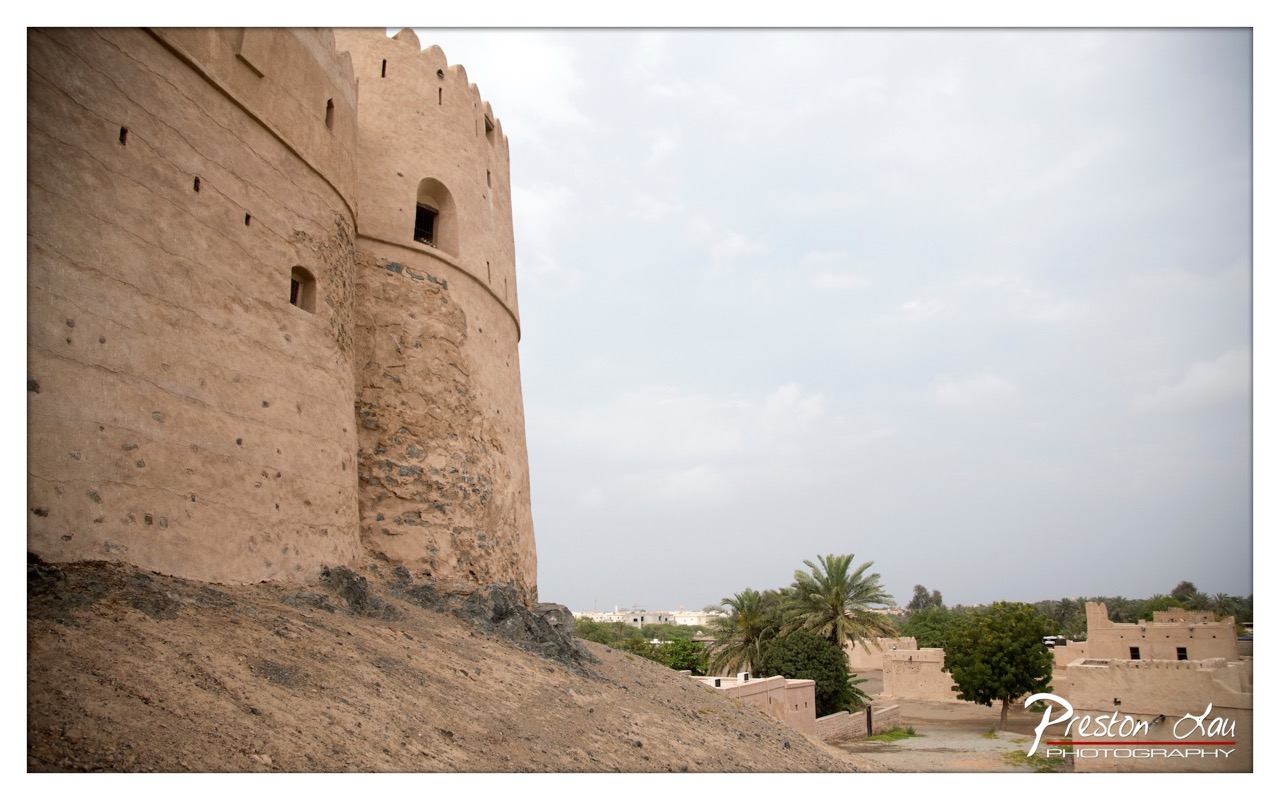

1. Overall Rating (0–10) — 7.0
This photograph captures the enduring presence of a traditional Middle Eastern fort, its weathered mud-brick walls standing as a testament to time and resilience. The expansive sky and distant palm trees evoke a sense of quiet isolation, grounding the structure in its cultural and geographical context. While the image succeeds in conveying atmosphere and historical weight, the muted lighting and slightly awkward framing limit its visual power, leaving it more documentary than evocative.
2. Composition (0–10) — 6.5
The fort dominates the left side of the frame, creating a strong vertical presence, but the right side feels underutilized, with an empty sky that dilutes tension. A tighter crop or repositioning could better balance the composition and draw focus to the relationship between the structure and its surroundings.
3. Lighting (0–10) — 5.5
The overcast sky casts a flat, diffused light that softens textures and reduces contrast, muting the rich earth tones of the mud-brick. While this creates a somber mood, it also drains the image of dynamic depth and visual energy.
4. Color & Tone (0–10) — 6.0
The palette is restrained, dominated by sandy beiges and muted grays, which align with the arid setting. However, the lack of vibrancy and tonal range gives the image a subdued, almost washed-out quality that diminishes its visual impact.
5. Creativity (0–10) — 6.5
The photographer captures a familiar subject with an authentic eye, emphasizing the quiet dignity of the architecture. While not groundbreaking in concept, the image reflects a thoughtful approach to cultural documentation and spatial storytelling.
6. Technical Quality (0–10) — 7.5
The image is sharp and well-focused, particularly on the textured wall, and the exposure is balanced. The clean detail in the brickwork and surrounding landscape demonstrates solid technical control.
7. Emotional Impact (0–10) — 6.0
The photograph conveys a sense of stillness and contemplation, inviting reflection on history and endurance. Yet, the lack of dramatic light and emotional intensity keeps the viewer at a respectful distance, limiting deeper connection.
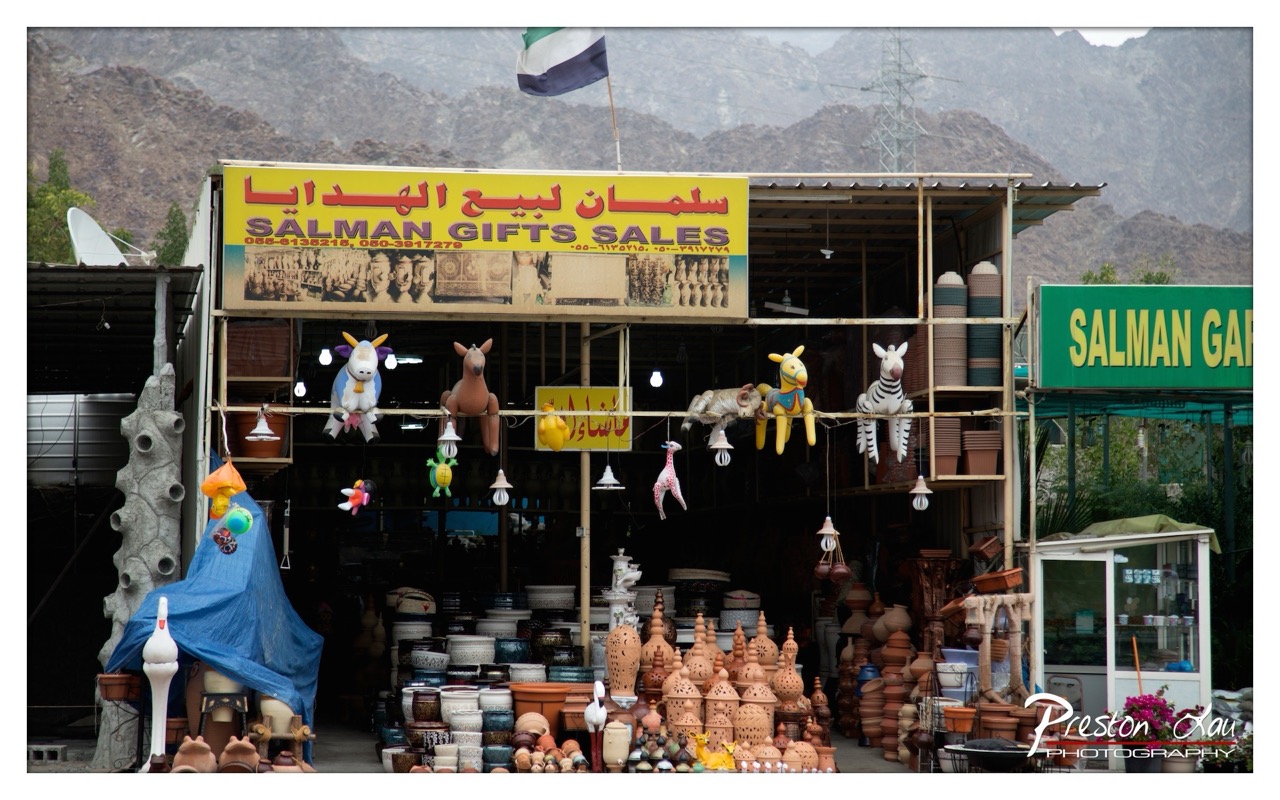

1. Overall Rating (0–10) — 7.0
This photograph captures the vibrant, eclectic energy of a traditional gift shop nestled against a rugged mountain backdrop, where cultural craft meets everyday commerce. The composition is rich with detail and texture, drawing the eye into a layered world of ceramics, toys, and handcrafted goods, while the muted natural light softens the scene into a warm, inviting tableau. The image succeeds in conveying both the commercial function and the artisanal soul of the place, though the slightly overcast sky tempers the visual punch of the colorful wares.
2. Composition (0–10) — 7.5
The frame is well-balanced, with the shop’s sign anchoring the center and the stacked pottery creating a strong vertical rhythm. The hanging toys and lanterns add depth and visual interest, while the mountains in the background provide a natural, grounding contrast to the man-made clutter.
3. Lighting (0–10) — 6.5
Soft, diffused daylight evenly illuminates the scene, minimizing harsh shadows and allowing the textures of the ceramics and painted figures to stand out. However, the lack of directional light limits depth and dramatic contrast, giving the image a slightly flat quality.
4. Color & Tone (0–10) — 7.0
The warm terracotta tones of the pottery harmonize beautifully with the earthy mountain backdrop, while the bright yellow sign and colorful hanging toys inject bursts of energy. The overall palette is rich and culturally resonant, though slightly muted by the overcast conditions.
5. Creativity (0–10) — 7.5
The photographer captures a moment of cultural authenticity, transforming a simple storefront into a story of tradition and trade. The inclusion of whimsical animal figures alongside functional ceramics creates a playful juxtaposition that feels both genuine and artistically engaging.
6. Technical Quality (0–10) — 8.0
Sharp focus and clear detail across the frame highlight the textures of the pottery and the fine print on the sign. The image is well-exposed, with no blown highlights or crushed shadows, and the watermark is discreet.
7. Emotional Impact (0–10) — 6.5
The photograph evokes a sense of curiosity and warmth, inviting the viewer to imagine the stories behind the crafts and the people who make and sell them. While it doesn’t elicit strong emotional resonance, it succeeds in creating a quiet, reflective mood tied to place and tradition.
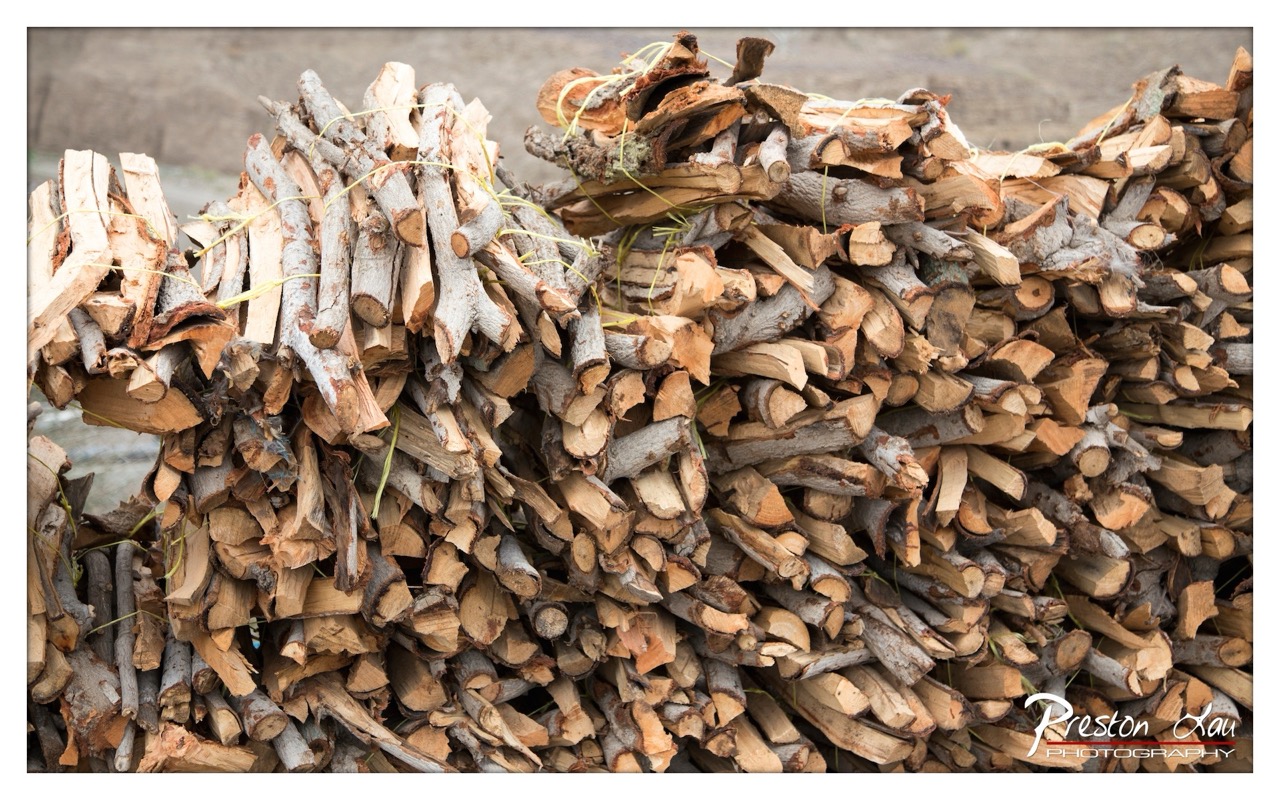

1. Overall Rating (0–10) — 6.0
This photograph captures the raw texture and quiet utility of a stacked woodpile, evoking a sense of rural preparation and seasonal labor. The natural grain and irregularity of the split logs lend an organic richness to the frame, though the composition feels slightly overfilled and lacks a clear focal point. While the image effectively conveys a tactile, grounded atmosphere, it remains more documentary than evocative, missing the emotional depth that would elevate it beyond a simple record.
2. Composition (0–10) — 5.5
The frame is tightly packed with wood, creating a busy texture that draws the eye in multiple directions. The diagonal flow of the logs offers some movement, but the lack of negative space or clear subject placement results in a cluttered, unbalanced feel.
3. Lighting (0–10) — 6.0
Diffuse, even lighting highlights the texture of the wood without creating harsh shadows. While it renders the scene clearly, the flatness of the light prevents any dramatic contrast or mood, contributing to a neutral, observational tone.
4. Color & Tone (0–10) — 6.5
The palette is composed of earthy browns, tans, and grays, harmonizing well and reinforcing the natural theme. However, the colors are somewhat muted, lacking vibrancy or warmth that could enhance the sense of hearth and home.
5. Creativity (0–10) — 6.0
The image is conceptually straightforward, focusing on the beauty of everyday materials. While it presents a familiar subject with a degree of visual interest, it does not offer a fresh perspective or strong narrative drive.
6. Technical Quality (0–10) — 7.5
The image is sharp and well-focused, with fine detail visible in the wood grain and bark. The exposure is balanced, and the overall clarity is strong, suggesting solid technical execution.
7. Emotional Impact (0–10) — 5.5
The photograph suggests a quiet, utilitarian rhythm—of gathering, preparing, and waiting—but fails to fully connect emotionally. The viewer is invited to observe rather than feel, limiting the image’s resonance.
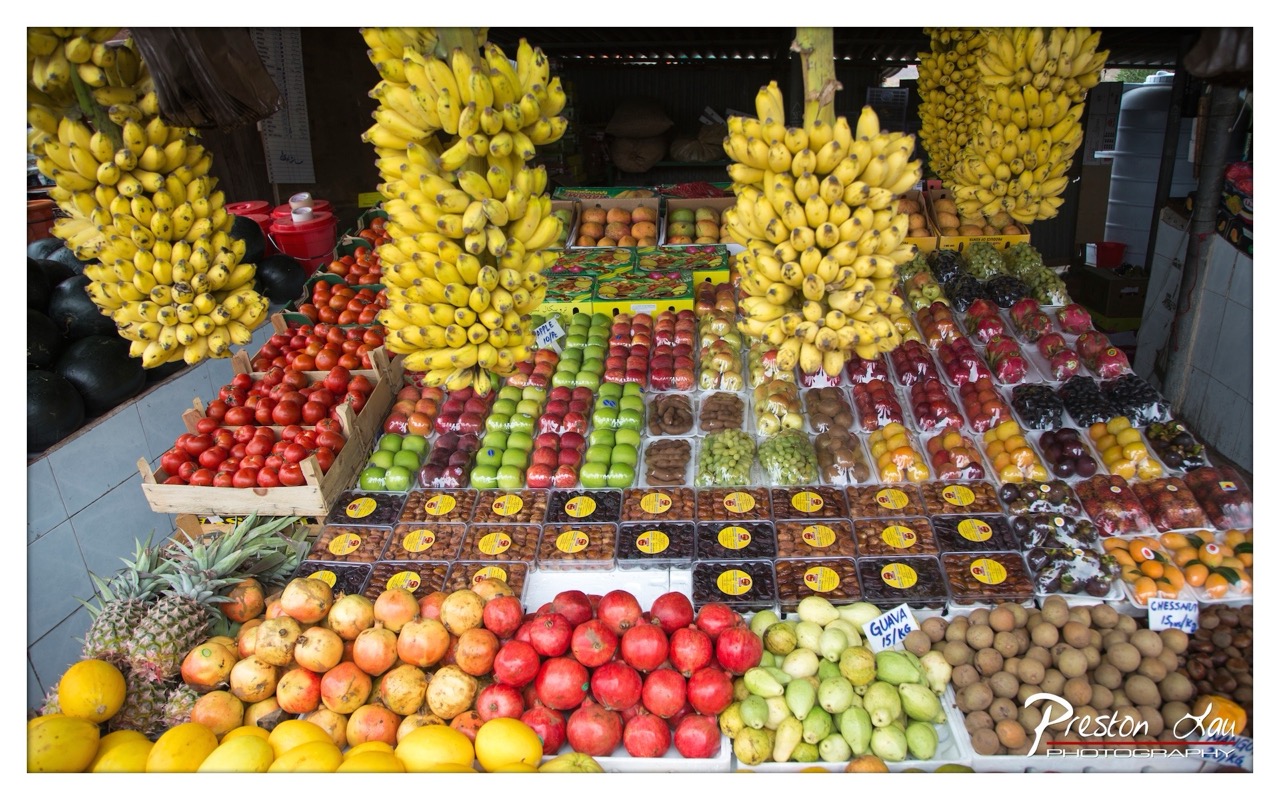

1. Overall Rating (0–10) — 7.5
This photograph bursts with the vibrant energy of a bustling fruit market, where color and abundance create an immediate sense of sensory richness. The tightly packed arrangement of produce, from hanging bananas to neatly stacked pomegranates, conveys a lively, authentic atmosphere. While the sheer density of elements risks visual chaos, the image succeeds in capturing the raw vitality of a local marketplace—its strength lies in its exuberance and cultural specificity, even if it sacrifices compositional elegance.
2. Composition (0–10) — 6.0
The frame is densely packed, with a strong diagonal flow from the bananas at the top to the foreground produce, but the cluttered arrangement creates visual competition rather than harmony. A more deliberate selection of focal points would enhance clarity.
3. Lighting (0–10) — 6.5
Natural overhead light illuminates the scene evenly, highlighting the colors of the fruit without harsh shadows. The slight overcast quality softens the light, allowing for rich saturation while maintaining detail across the display.
4. Color & Tone (0–10) — 8.0
The palette is a triumph of natural vibrancy—deep reds, bright yellows, and lush greens create a dynamic visual rhythm. The tonal contrast between the ripe fruits and the muted background tiles enhances the overall richness and depth.
5. Creativity (0–10) — 7.0
The image captures a common subject with a strong sense of place and cultural authenticity. While not radically original in concept, its immersive, documentary-style approach offers a fresh perspective on everyday life.
6. Technical Quality (0–10) — 8.0
Sharp focus across the frame ensures that textures and details—from the speckled skin of the mangoes to the glossy sheen of the pomegranates—are clearly rendered. The watermark is unobtrusive and professionally placed.
7. Emotional Impact (0–10) — 7.5
The image evokes a sense of warmth, abundance, and community, inviting the viewer to imagine the smells, sounds, and tastes of the market. It captures the joy of simple, everyday pleasures in a way that feels both intimate and universal.
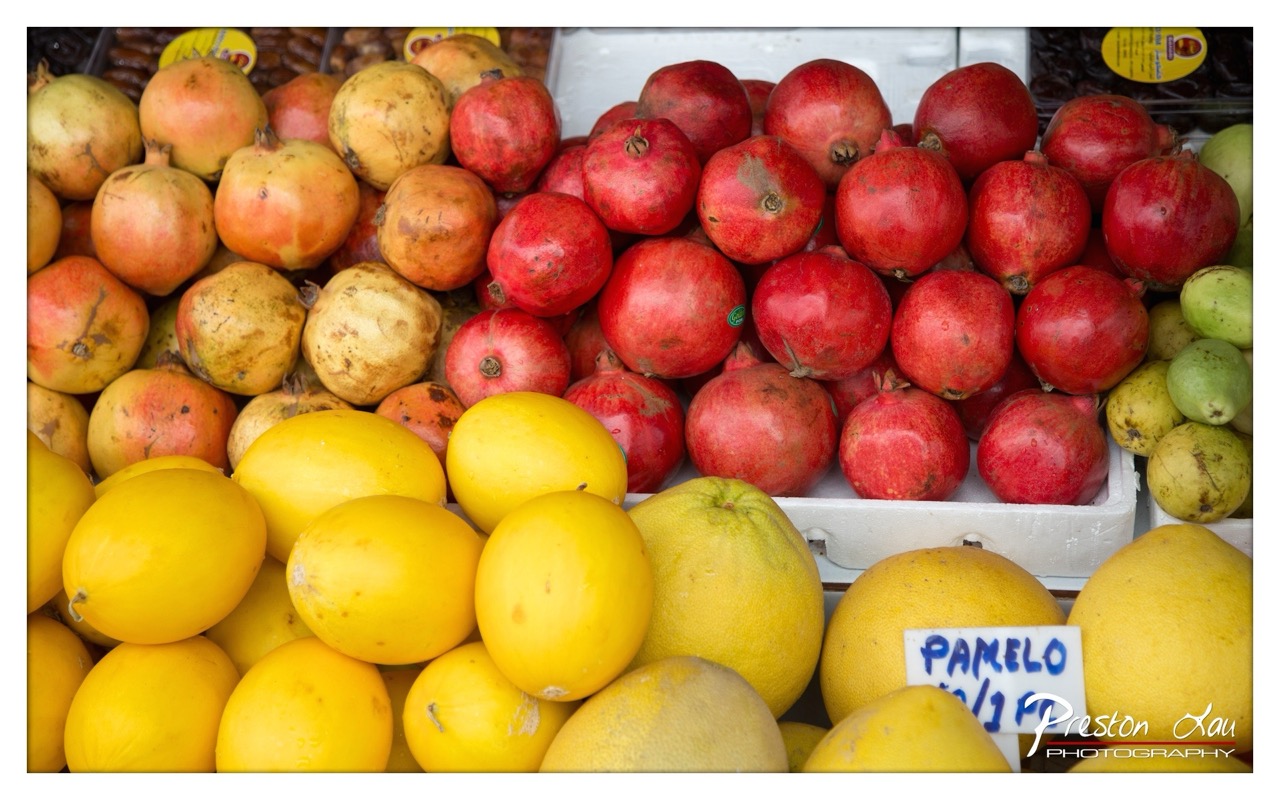

1. Overall Rating (0–10) — 7.5
This vibrant market display bursts with color and texture, capturing the lively abundance of fresh produce. The contrast between the bright yellow melons and the deep red pomegranates creates an immediately engaging visual rhythm, while the natural imperfections of the fruit lend authenticity. The composition is rich and inviting, though the slight clutter in the upper background slightly detracts from the overall clarity.
2. Composition (0–10) — 7.0
The image uses a strong diagonal arrangement, guiding the eye from the yellow melons in the foreground to the red pomegranates in the midground. The placement of the "PAMELO" sign adds a human element and anchors the composition, though the top edge feels slightly crowded with overlapping produce.
3. Lighting (0–10) — 8.0
Natural, diffused light enhances the vividness of the fruit, highlighting their textures without harsh shadows. The even illumination brings out the rich saturation of the colors while maintaining detail across the frame.
4. Color & Tone (0–10) — 9.0
The palette is striking—vibrant yellows and deep reds create a powerful contrast, enhanced by the subtle greens and earthy tones in the background. The tonal range is balanced, with the warm hues evoking a sense of freshness and abundance.
5. Creativity (0–10) — 7.5
The image captures a moment of everyday life with a strong sense of visual storytelling. The choice to focus on the interplay of color and form turns a simple market scene into a celebration of natural beauty, though it remains grounded in realism rather than conceptual innovation.
6. Technical Quality (0–10) — 8.0
The photograph is sharp and well-focused, with fine detail visible in the skin of the fruits. The depth of field is appropriate, keeping the foreground in crisp clarity while softly blurring the background, which enhances the sense of depth.
7. Emotional Impact (0–10) — 8.0
The image evokes a sense of warmth, abundance, and sensory delight—almost inviting the viewer to reach out and touch the ripe, colorful produce. The cheerful colors and organic textures create a joyful, almost nostalgic connection to the market experience.
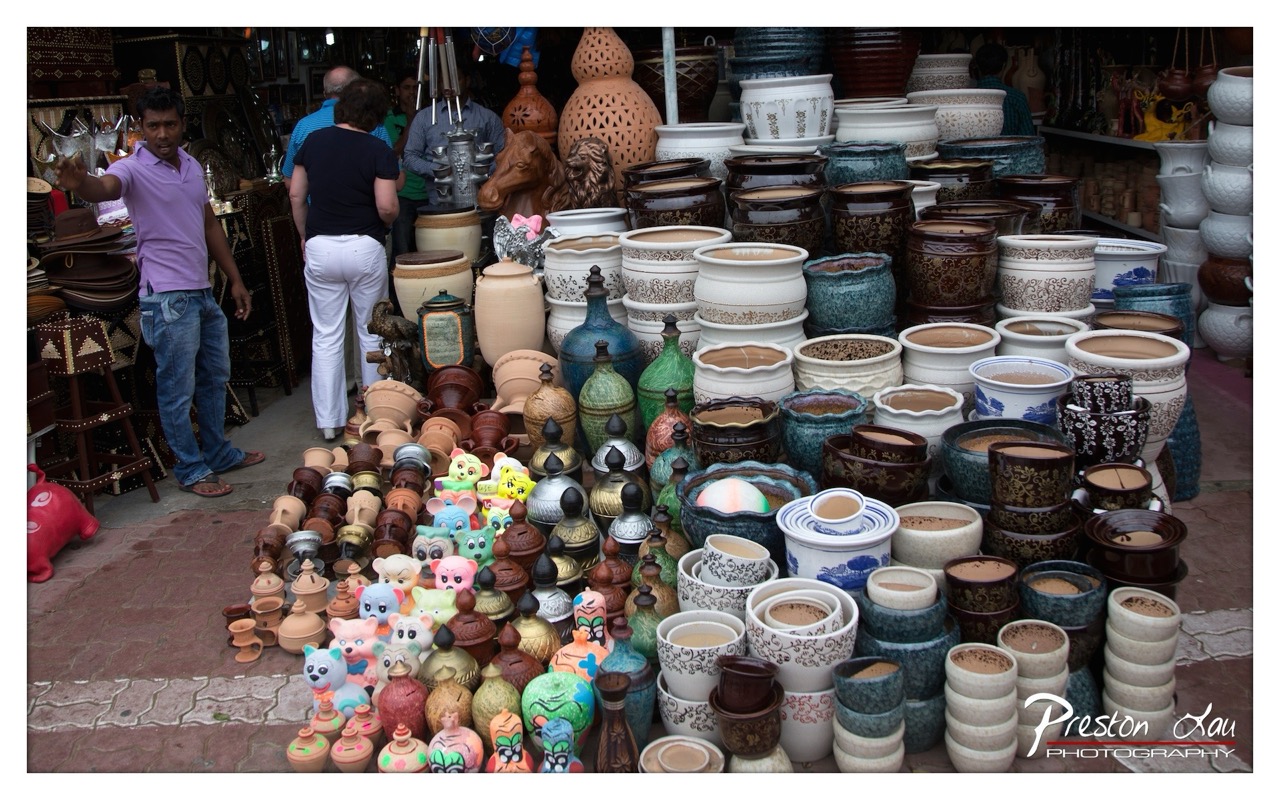

1. Overall Rating (0–10) — 7.0
This photograph captures the vibrant energy of a bustling market stall, where handmade ceramics and crafts spill across the pavement in a rich tapestry of color and texture. The scene is lively and full of cultural detail, with the vendor’s animated gesture adding a human element that draws the viewer into the moment. While the composition is dense and slightly chaotic, the image succeeds in conveying the sensory overload and authenticity of a traditional marketplace.
2. Composition (0–10) — 6.5
The frame is tightly packed with objects, creating a sense of abundance but sacrificing visual flow. The vendor on the left provides a natural entry point, though the cluttered foreground slightly overwhelms the central arrangement of ceramics.
3. Lighting (0–10) — 6.0
Natural daylight illuminates the scene evenly, highlighting the variety of glazes and textures. However, the lack of directional light results in a flatness that diminishes depth and shadow contrast.
4. Color & Tone (0–10) — 7.5
A diverse palette of earthy tones, deep blues, and bright pops of color from the figurines creates a visually engaging and culturally rich atmosphere. The saturation enhances the vibrancy of the pottery without appearing overprocessed.
5. Creativity (0–10) — 7.0
The image captures a moment of daily life with authenticity and narrative potential. The inclusion of both functional and whimsical items tells a story of craftsmanship and commerce, offering a glimpse into a local tradition.
6. Technical Quality (0–10) — 8.0
The image is sharp and detailed, with clear focus across the frame. The depth of field allows both foreground and background elements to remain discernible, showcasing the richness of the scene.
7. Emotional Impact (0–10) — 6.5
The photograph evokes a sense of curiosity and cultural immersion, inviting the viewer to imagine the sounds and conversations of the market. While the emotional resonance is strong, the sheer density of objects tempers the intimacy of the moment.
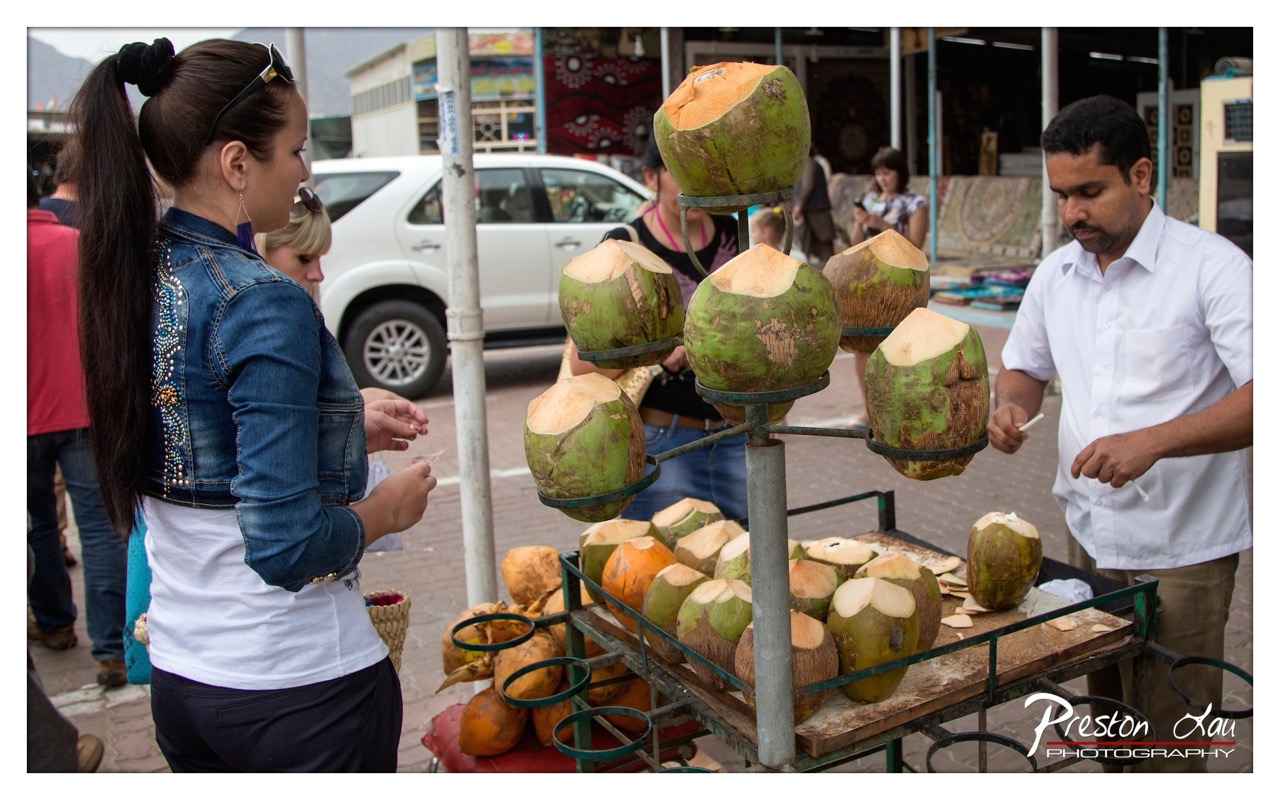

1. Overall Rating (0–10) — 7.0
This photograph captures a vibrant street scene where commerce and culture intersect, centered around the timeless ritual of selling fresh coconuts. The composition draws the eye to the interaction between vendor and customer, with the bright green coconuts forming a natural focal point. While the image is rich in narrative and authenticity, the slightly cluttered background and uneven lighting slightly detract from its visual harmony.
2. Composition (0–10) — 7.5
The subjects are well-framed, with the coconut stand acting as a visual anchor. The diagonal placement of the vendor and customer creates a sense of movement and interaction, while the depth of field effectively isolates the main action from the background.
3. Lighting (0–10) — 6.5
Natural daylight provides even illumination, though the overcast sky softens the contrast and shadows. The light is functional but lacks the warmth or drama that would elevate the mood.
4. Color & Tone (0–10) — 7.0
The green of the coconuts stands out against the muted urban backdrop, creating a pleasing contrast. The color palette feels authentic to the setting, with a balanced mix of earthy tones and subtle pops of color.
5. Creativity (0–10) — 7.5
The image tells a story of everyday life with a strong sense of place. The candid nature of the moment, combined with the central focus on the coconut stand, gives it a documentary charm that feels both original and relatable.
6. Technical Quality (0–10) — 8.0
The photograph is sharp and well-focused, particularly on the coconuts and the vendor’s hands. The depth of field is appropriate, and the image is free of technical flaws like noise or blur.
7. Emotional Impact (0–10) — 7.0
There’s a quiet warmth in the interaction between the vendor and the customer, suggesting a moment of connection in a busy street. The image evokes a sense of curiosity and appreciation for the small, everyday rituals that define local life.
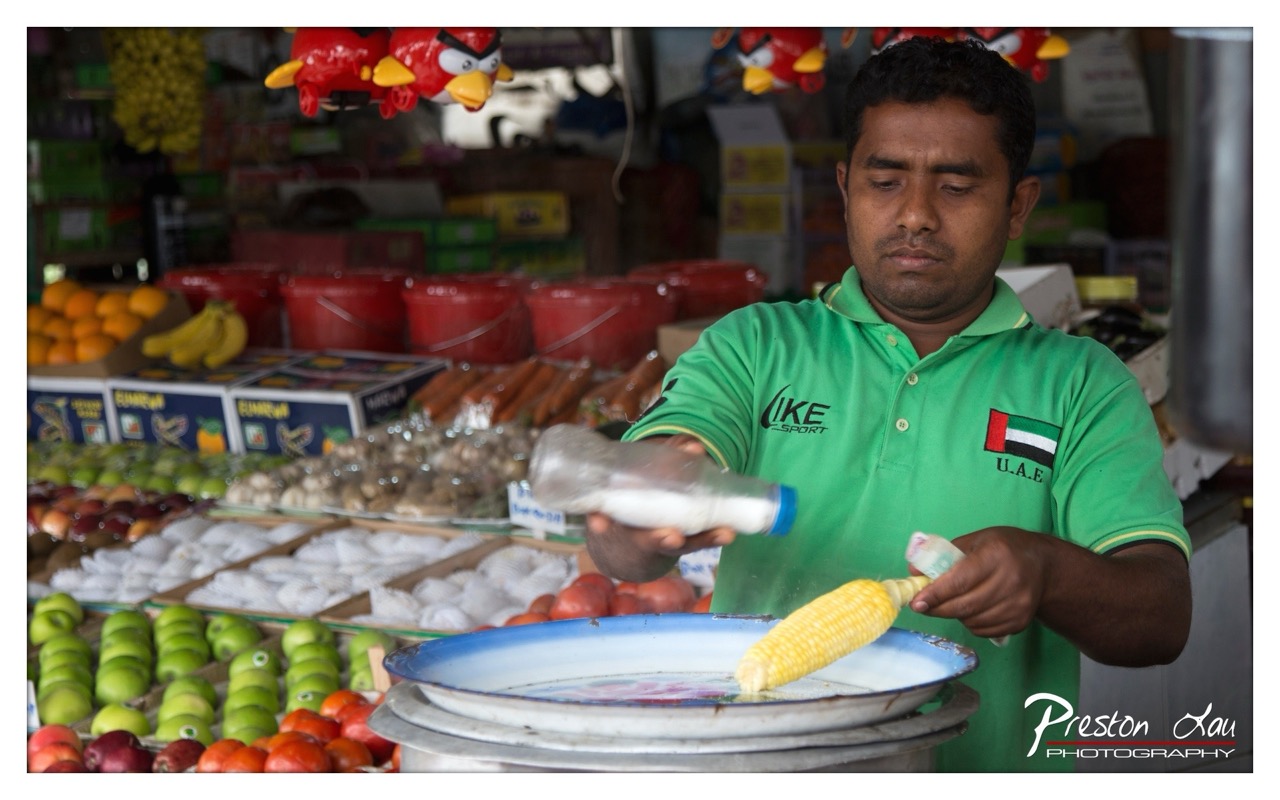

1. Overall Rating (0–10) — 7.0
This photograph captures a vivid moment of everyday life at a bustling market stall, where the vendor’s focused expression and the colorful array of produce create a sense of authenticity and cultural richness. The composition draws the viewer into the scene with a strong sense of place, though the busy background slightly distracts from the central subject. The image succeeds in telling a story of labor and commerce, with a subtle tension between the mundane and the visually compelling.
2. Composition (0–10) — 7.0
The subject is well-placed and framed to draw attention, with the vendor’s hands and corn creating a natural focal point. The depth of field effectively isolates the subject from the cluttered background, though the left side feels slightly unbalanced due to the concentration of produce.
3. Lighting (0–10) — 6.5
Natural light illuminates the scene evenly, preserving detail in both highlights and shadows. The overhead lighting casts a soft, even glow, though it lacks dramatic contrast, giving the image a slightly flat quality.
4. Color & Tone (0–10) — 7.5
The vibrant green of the vendor’s shirt contrasts sharply with the warm yellows and reds of the produce, creating a lively and engaging palette. The tones are rich and saturated, enhancing the sensory appeal of the market environment.
5. Creativity (0–10) — 7.0
The image blends documentary realism with a narrative quality, capturing both the action and the context of the moment. The inclusion of the Angry Birds decorations adds a touch of whimsy, subtly reflecting the blend of modern and traditional elements in the setting.
6. Technical Quality (0–10) — 8.0
The image is sharp and well-focused, with clean detail in the foreground subjects. The depth of field is well-managed, and the exposure is balanced, preserving texture and color accuracy.
7. Emotional Impact (0–10) — 6.5
The photograph evokes a sense of quiet dedication and cultural immersion, inviting the viewer to appreciate the dignity of daily work. While the emotional resonance is strong, it remains grounded in observation rather than overt sentimentality.
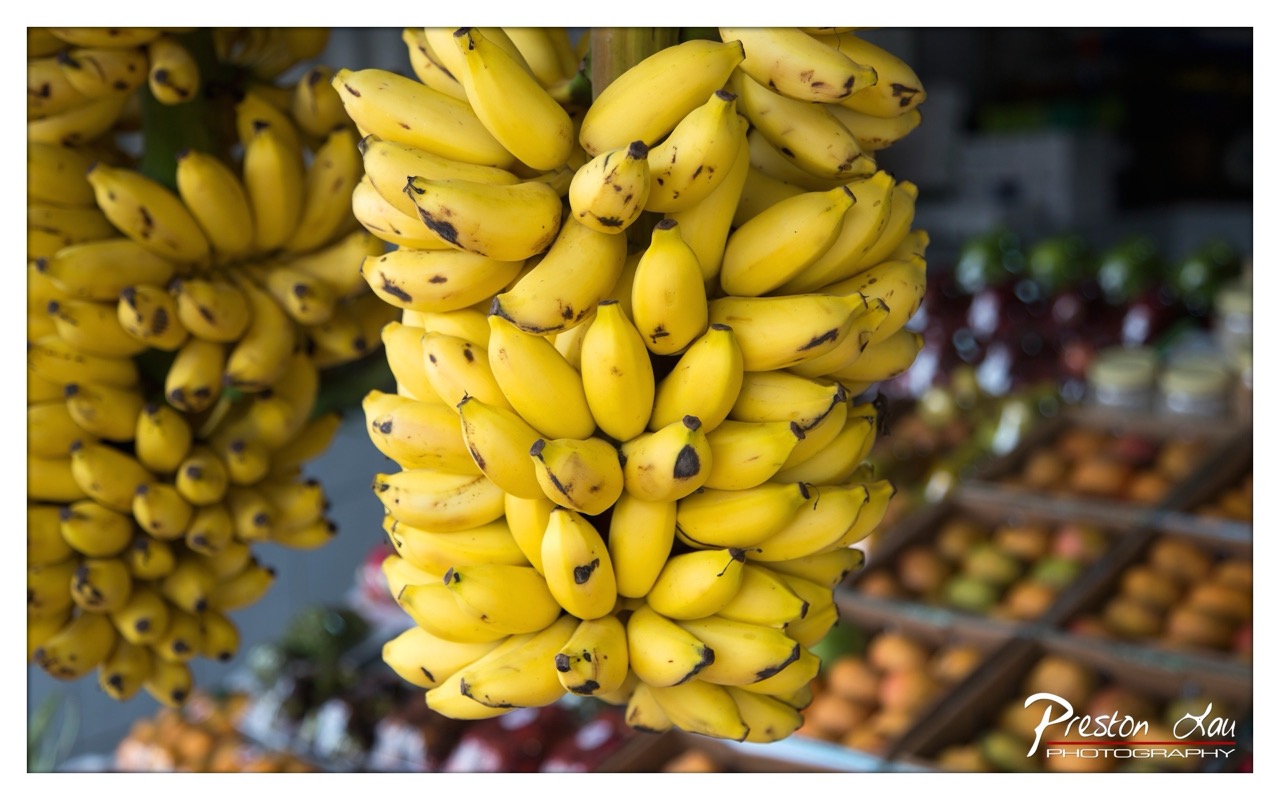

1. Overall Rating (0–10) — 7.5
This photograph captures the vibrant energy of a tropical fruit market, with clusters of ripe bananas drawing the eye through their rich yellow hue and organic form. The shallow depth of field beautifully isolates the main subject while hinting at the bustling environment beyond, creating a sense of immediacy and authenticity. While the composition is strong, the slightly busy background and lack of a more deliberate focal point hold it back from true artistic refinement.
2. Composition (0–10) — 7.0
The bananas are centered and dominate the frame, creating a strong focal point. The diagonal arrangement of the bunches adds dynamism, though the background elements, while softly blurred, still compete for attention.
3. Lighting (0–10) — 7.5
Natural light highlights the texture and curvature of the bananas, enhancing their freshness. The soft, diffused lighting creates gentle shadows and avoids harsh glare, contributing to the image’s inviting warmth.
4. Color & Tone (0–10) — 8.0
The bright yellow of the bananas contrasts vividly with the muted, earthy tones of the background. The color palette is rich and harmonious, with the warm yellows and browns evoking a sense of tropical abundance.
5. Creativity (0–10) — 7.0
The image successfully captures a slice of everyday life with artistic flair, using depth of field and color to elevate a simple subject. While not groundbreaking, it demonstrates a thoughtful approach to still-life storytelling.
6. Technical Quality (0–10) — 8.5
Sharp focus on the foreground bananas contrasts with a smoothly blurred background, indicating excellent control of aperture and focus. The image is clean, well-exposed, and free of technical flaws.
7. Emotional Impact (0–10) — 7.5
The photograph evokes a sense of warmth, abundance, and sensory delight—inviting the viewer to imagine the scent and taste of fresh fruit. The authenticity of the scene fosters a connection to place and culture.
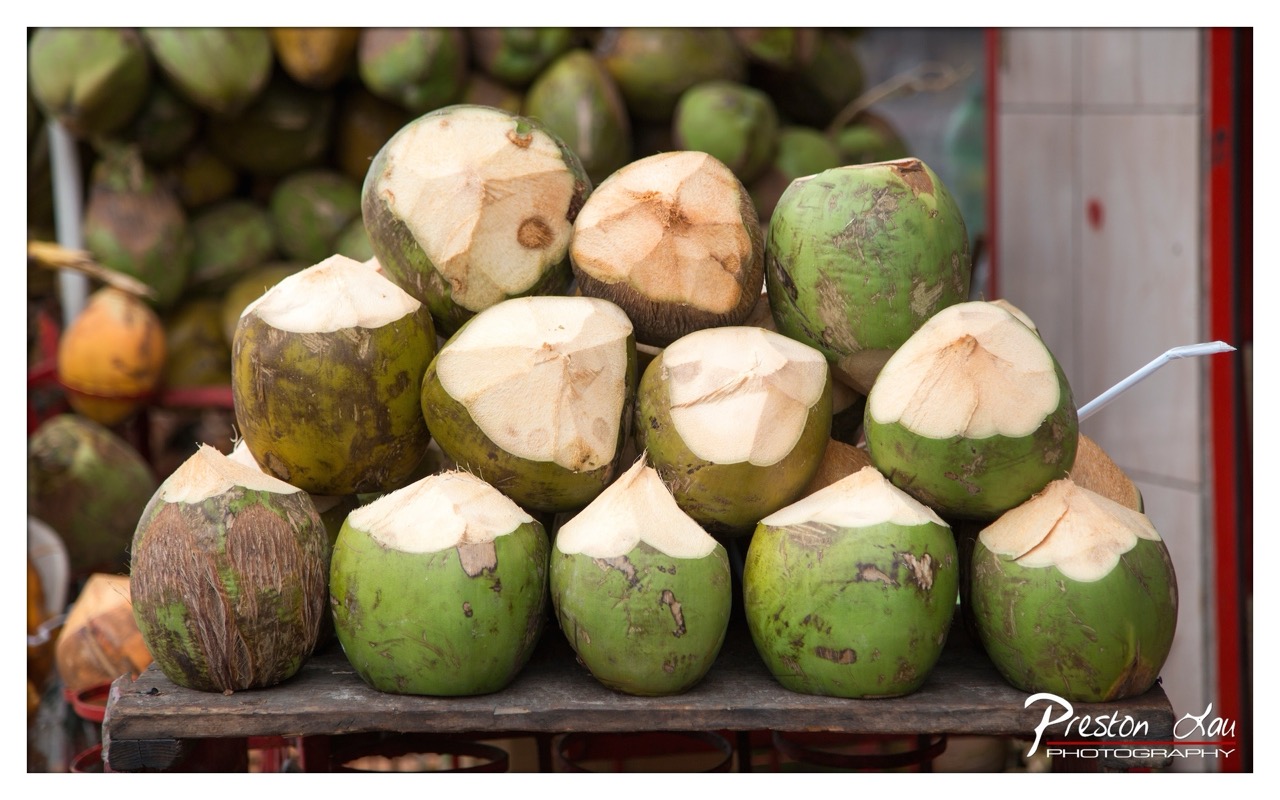

1. Overall Rating (0–10) — 7.0
This photograph captures the vibrant, tactile essence of a tropical market scene, where freshly opened coconuts invite the viewer into a sensory experience of coolness and refreshment. The rich green hues and the natural textures of the husks and flesh create a visually engaging still life, though the slightly cluttered background and uneven lighting temper its overall impact. With tighter composition and more intentional lighting, the image could achieve a more polished and immersive quality.
2. Composition (0–10) — 6.5
The coconuts are arranged in a dense, layered cluster that draws the eye forward, but the lack of clear focal hierarchy and the presence of distracting background elements reduce visual clarity. A tighter crop would better emphasize the subject and improve balance.
3. Lighting (0–10) — 6.0
The lighting is natural and even, but somewhat flat and unremarkable, lacking strong directional qualities that would create depth or highlight texture. A subtle shift in angle or time of day could enhance the interplay of light and shadow.
4. Color & Tone (0–10) — 7.5
The dominant green of the coconuts is rich and fresh, creating a strong sense of tropical vitality. The contrast between the pale flesh and the dark husks adds visual interest, and the overall tone is natural and appetizing.
5. Creativity (0–10) — 6.5
The image is grounded in realism and documentary appeal, capturing a familiar cultural moment with authenticity. While not highly conceptual, it successfully evokes a sense of place and experience through its subject and arrangement.
6. Technical Quality (0–10) — 8.0
The focus is sharp across the foreground coconuts, and the image is clean and well-exposed. The watermark is unobtrusive and does not detract from the visual integrity.
7. Emotional Impact (0–10) — 7.0
The photograph conveys a sense of warmth, refreshment, and everyday life, inviting the viewer to imagine the crisp sound of a knife cutting through a coconut and the taste of sweet water. The emotional resonance is rooted in familiarity and sensory appeal.
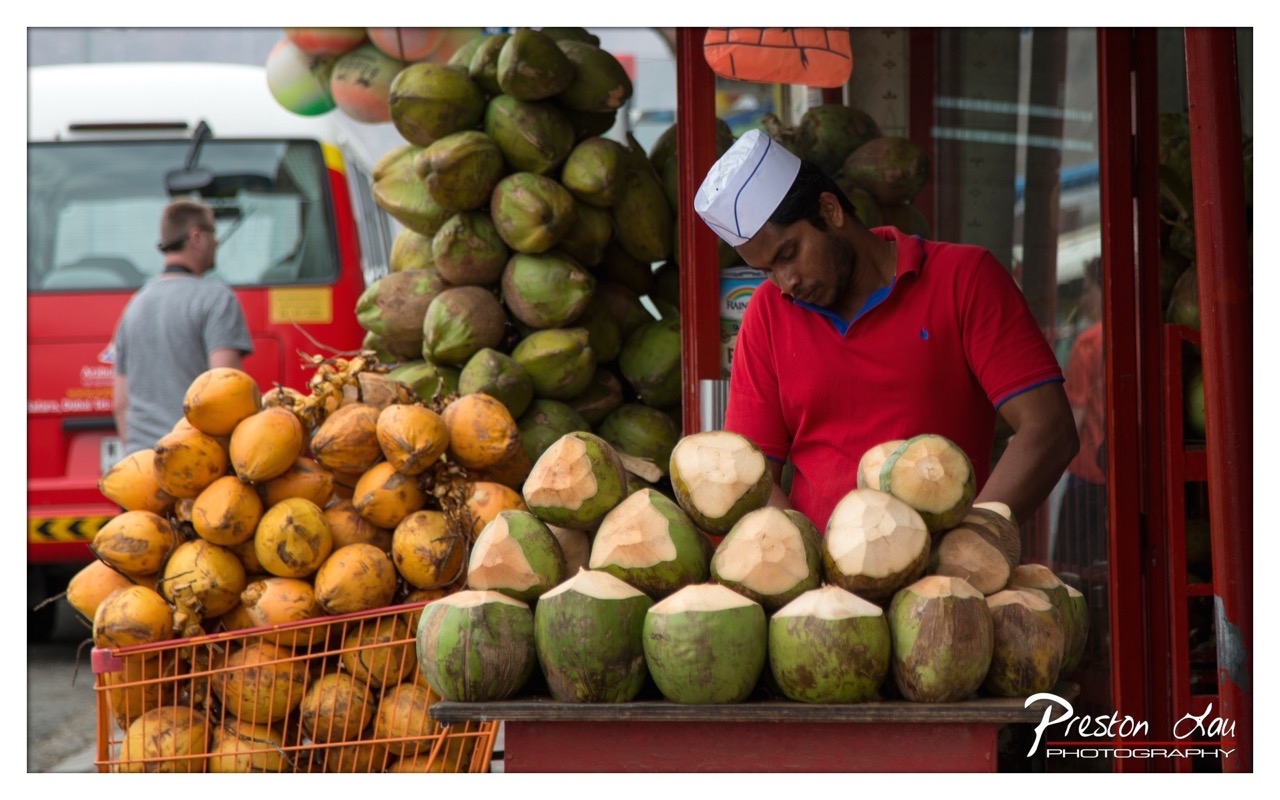

1. Overall Rating (0–10) — 7.5
This photograph captures the vibrant energy of a street vendor’s stall with rich cultural texture and a sense of daily rhythm. The juxtaposition of fresh coconuts, the vendor’s focused expression, and the bustling background creates a compelling narrative of labor and tradition. While the composition feels slightly cluttered, the image succeeds in conveying authenticity and warmth, drawing the viewer into a moment of everyday life.
2. Composition (0–10) — 6.5
The subject is well-placed on the right, but the left side feels crowded with the red vehicle and basket, creating visual imbalance. A tighter crop could improve focus and flow.
3. Lighting (0–10) — 7.0
Natural daylight provides even illumination, highlighting textures in the coconuts and the vendor’s face. The soft shadows add depth without overpowering the scene.
4. Color & Tone (0–10) — 8.0
The vivid red of the vendor’s shirt and the stall contrasts beautifully with the green and yellow coconuts, creating a dynamic and tropical palette. The color balance feels natural and engaging.
5. Creativity (0–10) — 7.0
The image captures a moment with cultural specificity and narrative potential, though it leans more toward documentary than conceptual innovation.
6. Technical Quality (0–10) — 8.0
Sharp focus on the coconuts and vendor, with clear detail throughout. The depth of field effectively isolates the subject while keeping background context.
7. Emotional Impact (0–10) — 7.5
The quiet concentration of the vendor and the sensory richness of the scene evoke a sense of connection to place and labor, inviting empathy and curiosity.
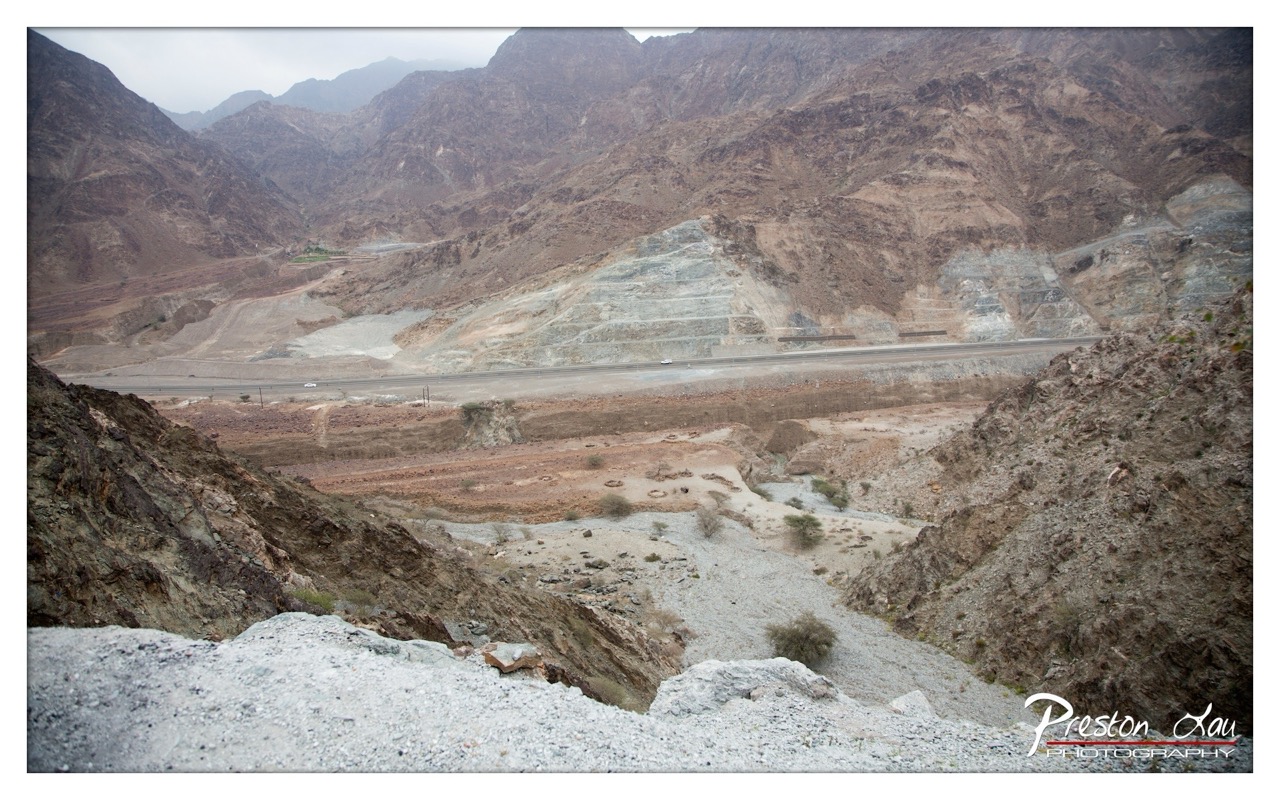

1. Overall Rating (0–10) — 7.0
This photograph captures the stark grandeur of a mountainous desert landscape, where human infrastructure cuts through the raw terrain with quiet persistence. The layered rock face and winding road convey a sense of scale and isolation, while the muted palette enhances the arid mood. Though the image is compelling in its realism, it lacks a strong emotional hook, feeling more like a travel snapshot than a deeply evocative work.
2. Composition (0–10) — 6.5
The wide framing effectively captures the vastness of the valley, with the road acting as a leading line that draws the eye into the distance. However, the foreground rocks slightly disrupt the visual flow, and the composition feels unbalanced due to the heavy mass on the left.
3. Lighting (0–10) — 6.0
The overcast sky provides soft, diffused light that minimizes harsh shadows, allowing for even detail across the landscape. While this prevents blown highlights, it also flattens the scene, diminishing the dramatic contrast that could elevate the mood.
4. Color & Tone (0–10) — 6.5
The palette is dominated by earthy browns, grays, and muted greens, which suit the arid environment. However, the colors lack vibrancy and warmth, giving the image a slightly drab quality that undercuts its potential visual impact.
5. Creativity (0–10) — 6.0
The juxtaposition of natural geology and human engineering is conceptually strong, but the image plays it safe—there’s little stylistic innovation or narrative depth. It’s a straightforward documentation rather than an artistic interpretation.
6. Technical Quality (0–10) — 7.5
The image is sharp and clear, with fine detail visible in the rock textures and distant landscape. Focus is consistent, and the exposure is well-managed, despite the limitations of the overcast conditions.
7. Emotional Impact (0–10) — 6.5
The photograph evokes a sense of solitude and endurance, but the emotional resonance is muted by the lack of dramatic lighting and compositional tension. It invites contemplation of human presence in harsh environments, but doesn’t deeply move.
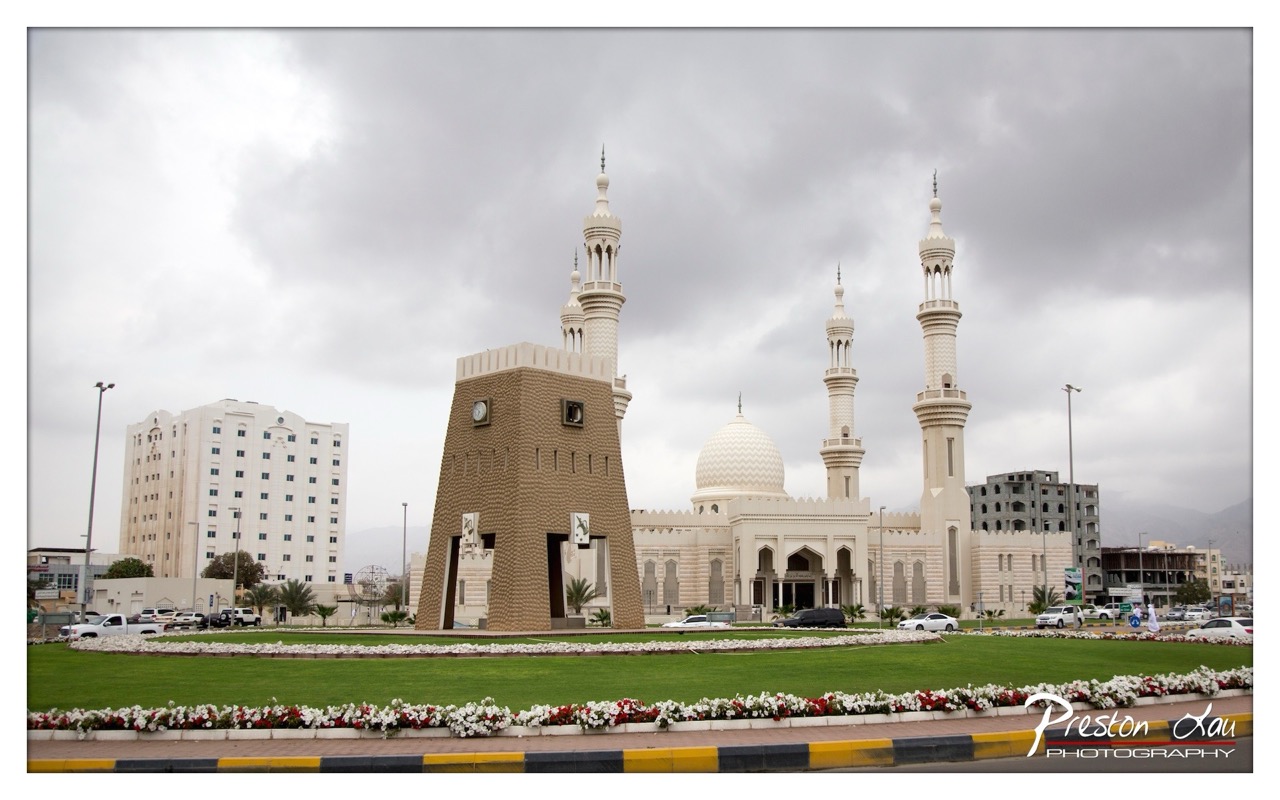

1. Overall Rating (0–10) — 6.8
This photograph captures a striking blend of modern and traditional Islamic architecture under a brooding, overcast sky, creating a mood of solemn grandeur. The white mosque with its domes and minarets stands in contrast to the earth-toned, geometric tower in the foreground, suggesting a dialogue between cultural heritage and contemporary urban development. While the image is well-framed and rich in detail, the flat lighting and muted colors slightly dampen its emotional resonance, preventing it from feeling fully immersive.
2. Composition (0–10) — 7.0
The central placement of the mosque and the asymmetrical inclusion of the tower create a balanced yet dynamic composition. The foreground lawn and flowerbeds guide the eye toward the architectural subjects, while the surrounding buildings and traffic add context without overwhelming the focal point.
3. Lighting (0–10) — 5.5
Diffused, overcast lighting softens shadows and evenly illuminates the scene, but it also flattens textures and reduces atmospheric depth. The lack of strong directional light diminishes the visual drama of the architecture.
4. Color & Tone (0–10) — 6.0
The palette is dominated by neutral whites and beiges, with the green lawn and red-and-white flowerbeds providing subtle color accents. While harmonious, the overall tone is subdued, lending a somber quality to the image.
5. Creativity (0–10) — 7.0
The juxtaposition of the traditional mosque with the modern tower and surrounding urban environment offers a compelling narrative about cultural continuity and urban evolution. The photographer’s choice to include the clock tower adds a layer of symbolic depth.
6. Technical Quality (0–10) — 7.5
The image is sharp and well-focused, with clean details visible in the architecture and landscaping. The exposure is balanced, and the resolution is high, allowing for clear viewing of the scene’s intricacies.
7. Emotional Impact (0–10) — 6.5
The image evokes a sense of reverence and quiet contemplation, enhanced by the overcast sky and the imposing scale of the structures. However, the lack of vibrant light and dynamic contrast keeps the emotional pull from fully engaging the viewer.
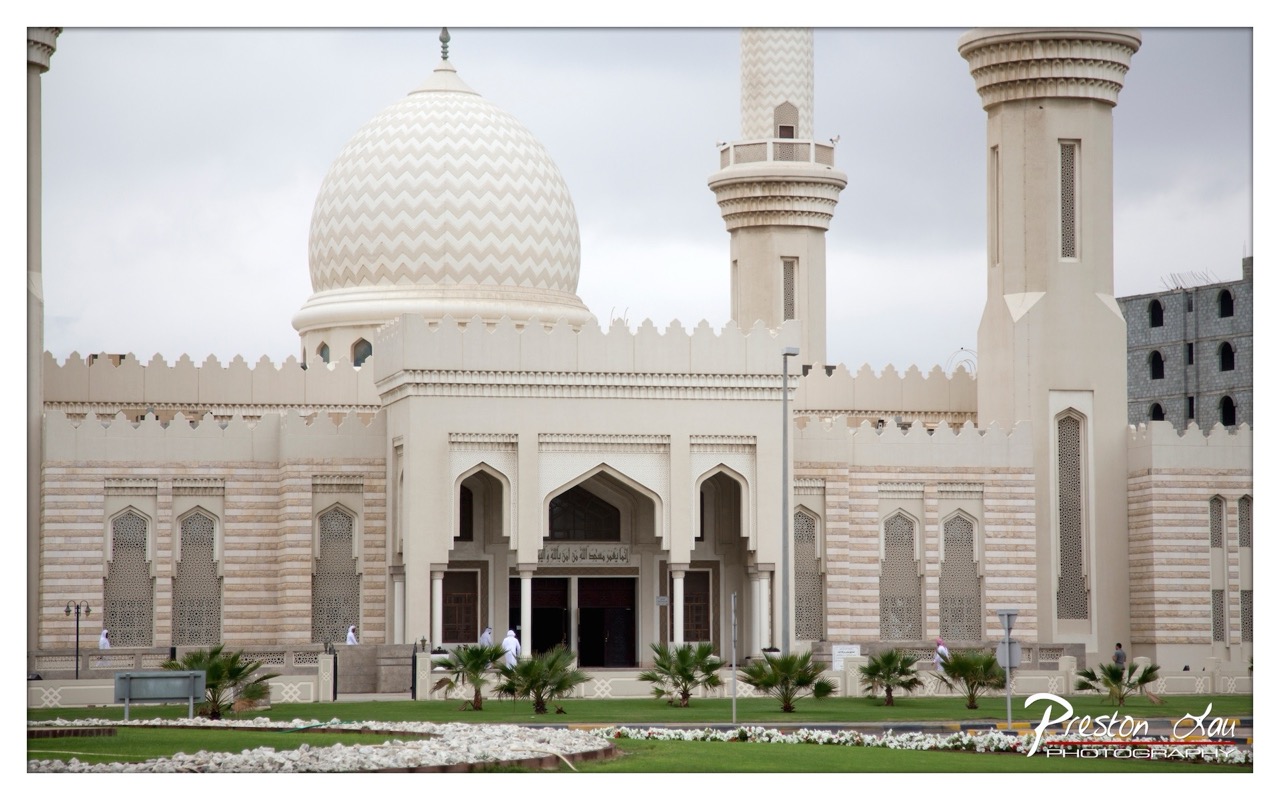

1. Overall Rating (0–10) — 7.0
This photograph captures the serene grandeur of a modern Islamic mosque, where architectural symmetry and cultural detail combine to evoke a sense of reverence. The white-on-white dome and minarets stand out against the muted sky, creating a striking visual harmony. While the image is strong in composition and clarity, the overcast lighting tempers its emotional intensity, leaving the scene feeling more documentary than transcendent.
2. Composition (0–10) — 7.5
The central placement of the mosque’s main entrance and dome establishes a strong focal point, while the repeating arches and vertical lines create a sense of rhythm and balance. The foreground lawn and palm trees add depth and context without distracting from the architecture.
3. Lighting (0–10) — 6.0
Diffused light from the overcast sky softens shadows and evenly illuminates the structure, minimizing harsh contrasts. While this prevents glare and preserves detail, it also flattens the scene’s dimensionality and reduces the dramatic effect of the light.
4. Color & Tone (0–10) — 6.5
The palette is dominated by soft cream and beige tones, with subtle variations in the stone and stonework. The green of the grass and white flowers in the foreground offer gentle contrast, but the overall tonal range is subdued, giving the image a calm but slightly muted quality.
5. Creativity (0–10) — 7.0
The image successfully captures the elegance and spiritual presence of the mosque through careful framing and attention to architectural detail. While the approach is traditional and observational, the choice to highlight the intricate patterns and symmetry shows thoughtful artistic intent.
6. Technical Quality (0–10) — 8.0
The photograph is sharp and well-focused, with clean lines and clear detail in both the foreground and background. The exposure is balanced, and the resolution is high, allowing for fine texture in the stonework and dome.
7. Emotional Impact (0–10) — 6.5
The image conveys a sense of peace and order, inviting quiet reflection. However, the lack of dynamic lighting and emotional contrast keeps the viewer at a respectful distance, limiting the depth of emotional resonance.
Loading map...